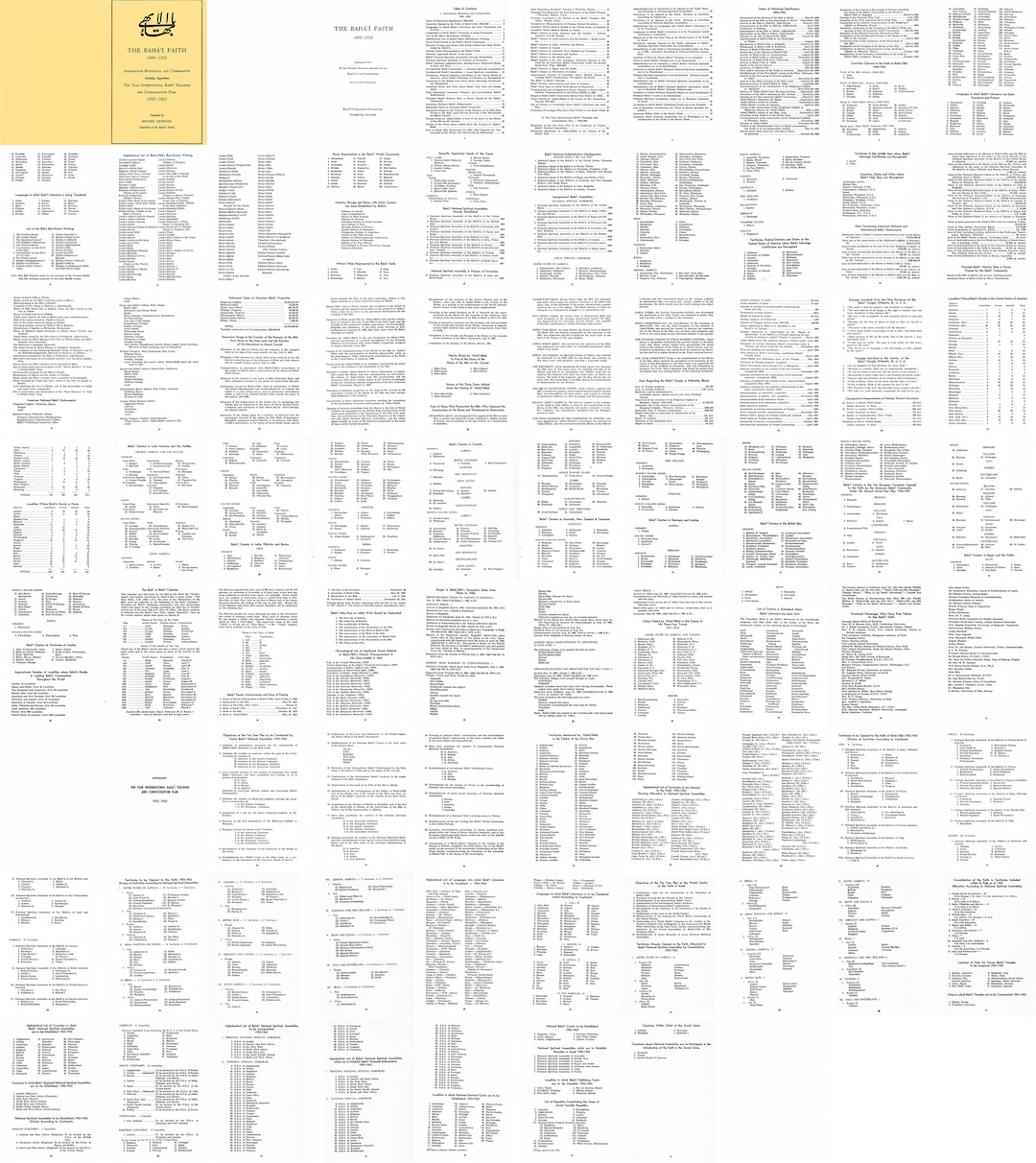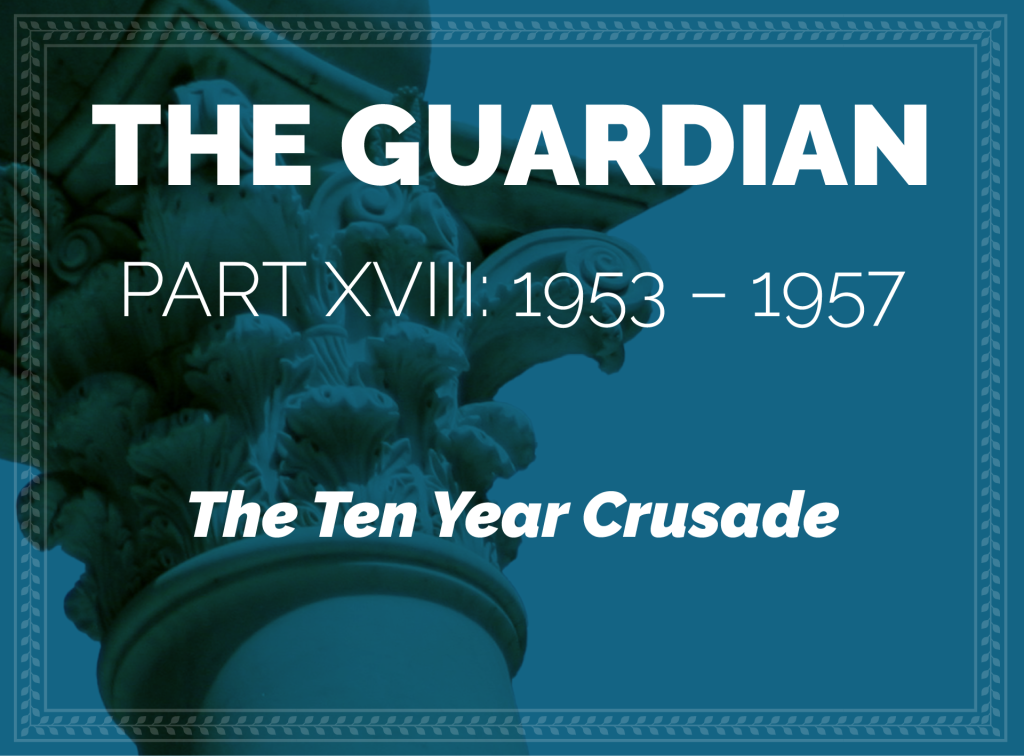
Written and illustrated by Violetta Zein
This part covers the life of Shoghi Effendi from the age of 56 in 1953 to the age of 60 in 1957.
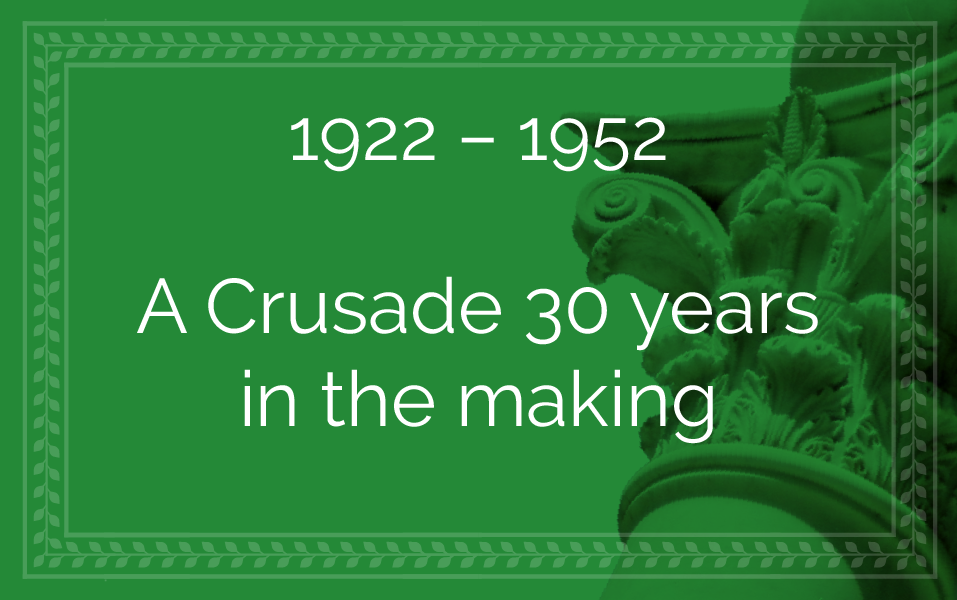
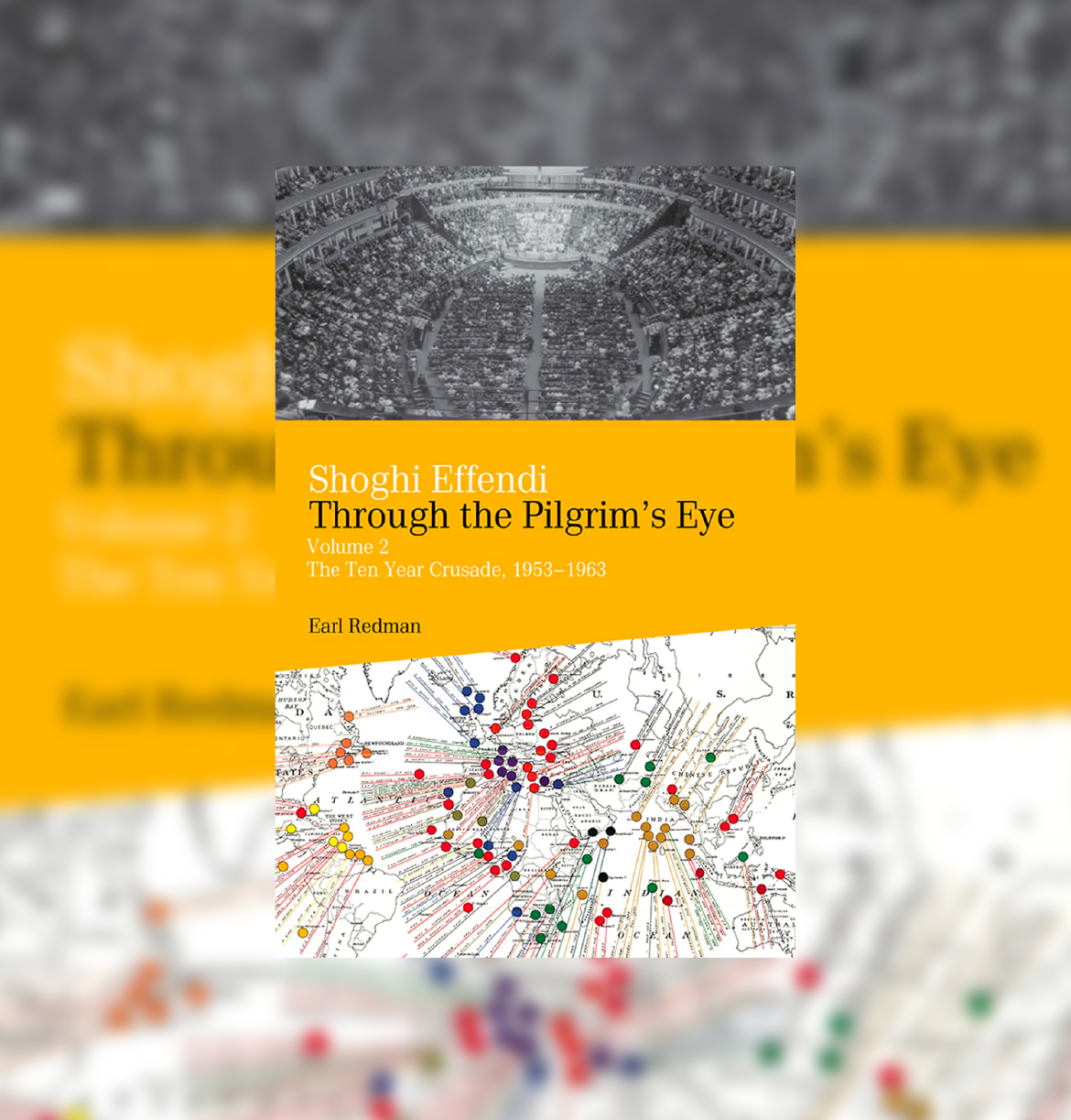
The next story quotes details from the second volume of Earl Redman’s two-part series on Shoghi Effendi Through the Pilgrim’s Eye, and this book is so important that it should be properly introduced.
Shoghi Effendi Through the Pilgrim’s Eye, Volume 2 The Ten Year Crusade, 1953-1963 covers the years 1953-1963, and, for our purposes, the last four years of the Guardian’s momentous life, as he was prosecuting the worldwide Ten Year Crusade.
This is yet another example of Earl Redman’s original scholarship in regards to Bahá'í history, and his deep-dive into journals and archives, in order to continue building a portrait of Shoghi Effendi, Guardian of the Bahá'í Faith, through the eyes of those who were privileged to meet him.
Earl Redman’s books, because they extensively quote from first-person diaries, allow us to form a personal bond with Shoghi Effendi, and feel, through the words of those who entered into his presence—sometimes briefly, sometimes for long periods of time, but always very powerfully—what it was like to be in the same room as the Guardian, to hear him speak, to listen to his words, and to be transformed by the experience.
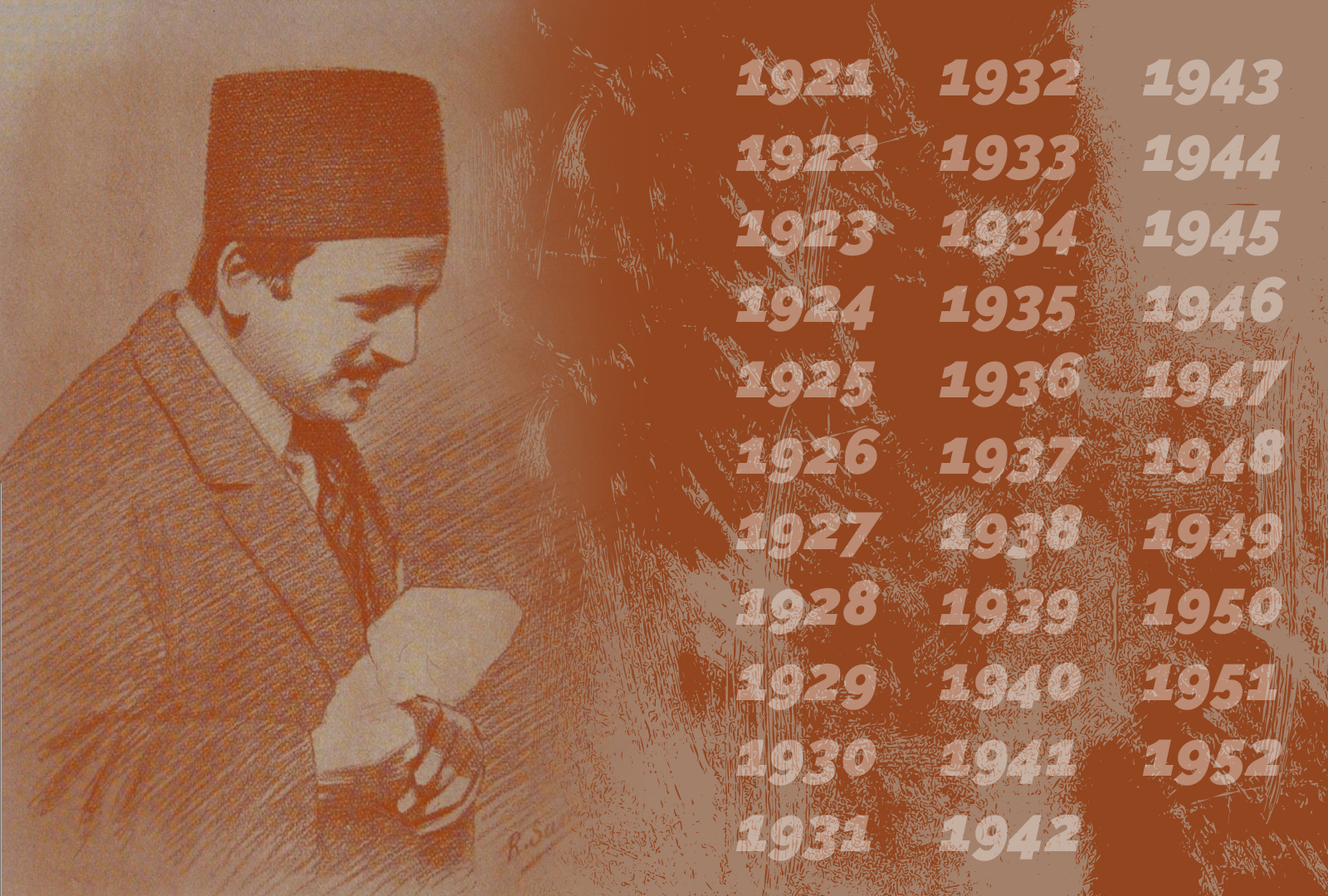
Sepia pencil drawing by Reza Samimi, made from the photograph in the first year of Shoghi Effendi’s Guardianship, taken by pilgrim Boyce Nourse. Source: Frontispiece of Shoghi Effendi: Recollections, Ugo Giachery, George Ronald, 1973.
‘Alí Nakhjávání closely examined the letters that Shoghi Effendi wrote to the Bahá'í world and to individual National Spiritual Assemblies during the 30 years of his ministry prior to launching the Ten Year Crusade. He discovered that the Guardian had been preparing the Bahá'í world since 1921 for the climax of the World Crusade.
These three decades of letters, cables, and telegrams from the Guardian, in ‘Alí Nakhjávání’s opinion, distinctly show that the Ten Year Crusade had long been destined to be the culmination of processes the Guardian had inaugurated at the start of the Formative Age, at the very beginning of his ministry, and that they were also meant to be a springboard for the glorious victories in the epochs of the Formative age to come.
By 1937, the momentous teaching plans of 'Abdu'l-Bahá revealed in His Tablets of the Divine Plan had been held in abeyance for 20 years and the Guardian decided the time was ripe to inaugurate them. Because they had been addressed to the Bahá'ís of the United States and Canada, the Guardian inaugurated the very first teaching Plan addressed to American Bahá'ís—“envied custodians of a Divine Plan”—the first teaching Plan of the Formative Age, the First Seven Year Plan, which began in 1937 and concluded in 1944.
At the conclusion of the First Seven Year Plan in 1944, two decades after the start of the Formative and 23 years exactly after the passing of 'Abdu'l-Bahá, Shoghi Effendi had announced that the first Epoch of the Formative Age had concluded. The writings of the Guardian unmistakably point out that this first Epoch consisted of two stages: 16 years during which 11 National Spiritual Assemblies had been formed, along with Local Spiritual Assemblies `and 7 years during which the Local and National Institutions had been consolidated.
In 1946, following two years of respite given to the North American Bahá’í community, the Guardian called upon it to initiate its Second Seven-Year Plan—a Plan designed to end with the Centenary of the Birth of the Bahá’í Revelation in 1953. Shoghi Effendi’s plans were becoming clearer to those Bahá'ís who could see where he was leading them. The Guardian had an unmistakably clear vision he was pursuing.
The next stage in the Guardian’s plan were National Plans, all ending in 1953.

World map showing the 12 National Plans initiated by the Guardian in preparation for the Ten Year Crusade. Map built on an asset map designed by Freepik.
When the Guardian launched the Crusade, he held the hands of National Spiritual Assemblies, and outlined 14 plans for National and Regional Spiritual Assemblies, and one for the Women in Iran. The Guardian called these National Plans “accessory plans” supplementing the second Seven-Year Plan of the North American continent.
The last Teaching Plan the Guardian inaugurated in his ministry was the Ten Year Crusade. Not only was the Ten Year Crusade the first truly universal worldwide Teaching Plan, but it was also the Guardian’s most ambitious, broadest, and widest-reach Plan to date: its goal was to plant the banner of the Faith of Bahá'u'lláh throughout the entire length and breadth of the earth, into the farthest, most remote areas of all continents, and the most isolated islands of the oceans.
The spiritual foundation of the Ten Year Crusade was a series of national plans the Guardian gave various national communities in preparation for this monumental enterprise, all of these Plans ending in 1953, when the Ten Year Crusade would begin:
- The United States and Canada’s Second Seven Year Plan (1946-1953)
- Australia and New Zealand’s Six Year Plan (1947-1953)
- Canada’s Five Year Plan (1948-1953)
- The Egypt and the Sudan’s Five Year Plan (1948-1953)
- Germany and Austria’s Five Year Plan (1948-1953)
- The African Campaign (1950-1953)
- Iraq’s Three Year Plan (1950-1953)
- The British Isles’ Two Year Plan (1951-1953)
- India, Pakistan and Burma’s Four-and-a-Half Year Plan (January 1946–July 1950)
- India, Pakistan and Burma’s Nineteen Month Plan (1951-1953)
- South America’s Two Year Plan (1951-1953)
- Central America’s One Year Plan (1952-1953)
At the start of the Ten Year Crusade, the Guardian had 12 National Spiritual Assemblies operating under his guidance, which he called his twelve “generals” and repeatedly referred to them as the future “pillars” of the Universal House of Justice.
All these accessory National Plans ended in 1953 when the Guardian launched his Ten Year global Crusade, which mobilized the entire Baha'i world in one "army of light" directed from the Baha'i World Centre.
The Guardian Ten Year Crusade a "historic spiritual venture at once arduous, audacious, challenging, unprecedented in scope," a venture that would call upon the 12 National Spiritual Assemblies then in existence to coordinate their work and concentrate their pioneers, funds and expertise on the winning of common goals.
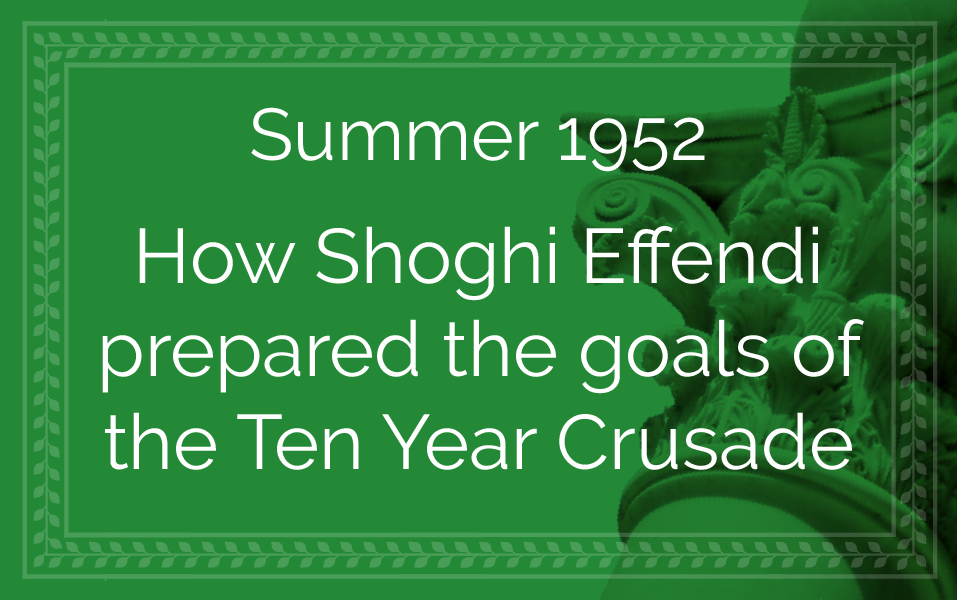

The Wheels of Bahá'u'lláh’s Chariot. Map of the 11 National Spiritual Assemblies in existence in 1952—in shades of blue—with circles around each National Spiritual Assembly and projected National Spiritual Assemblies—in shades of yellow—also with circles around each institution. The list of projected National Spiritual Assemblies was taken from the April 1955 message from Shoghi Effendi in Messages to the Bahá’í World: 1950–1957, in the section titled SIXTEEN NEW NATIONAL ASSEMBLIES BY RIDVAN, 1957, pages 81-83. Map created on an asset designed by Freepik.
One night at dinner, Shoghi Effendi called out for a world map. This happened some time before 9 July 1952—when Jessie Revell, Treasurer of the International Bahá'í Council recounted the story in a letter she sent to the American Bahá'ís.
On the map, the Guardian drew 11 circles around the countries of the current 11 Bahá'í National Spiritual Assemblies. Then, he drew 11 circles encompassing the countries where 11 National Spiritual Assemblies would be established by the end of the Ten Year Crusade.
And he called the 22-circle map “The Wheels of Bahá'u'lláh’s Chariot.”
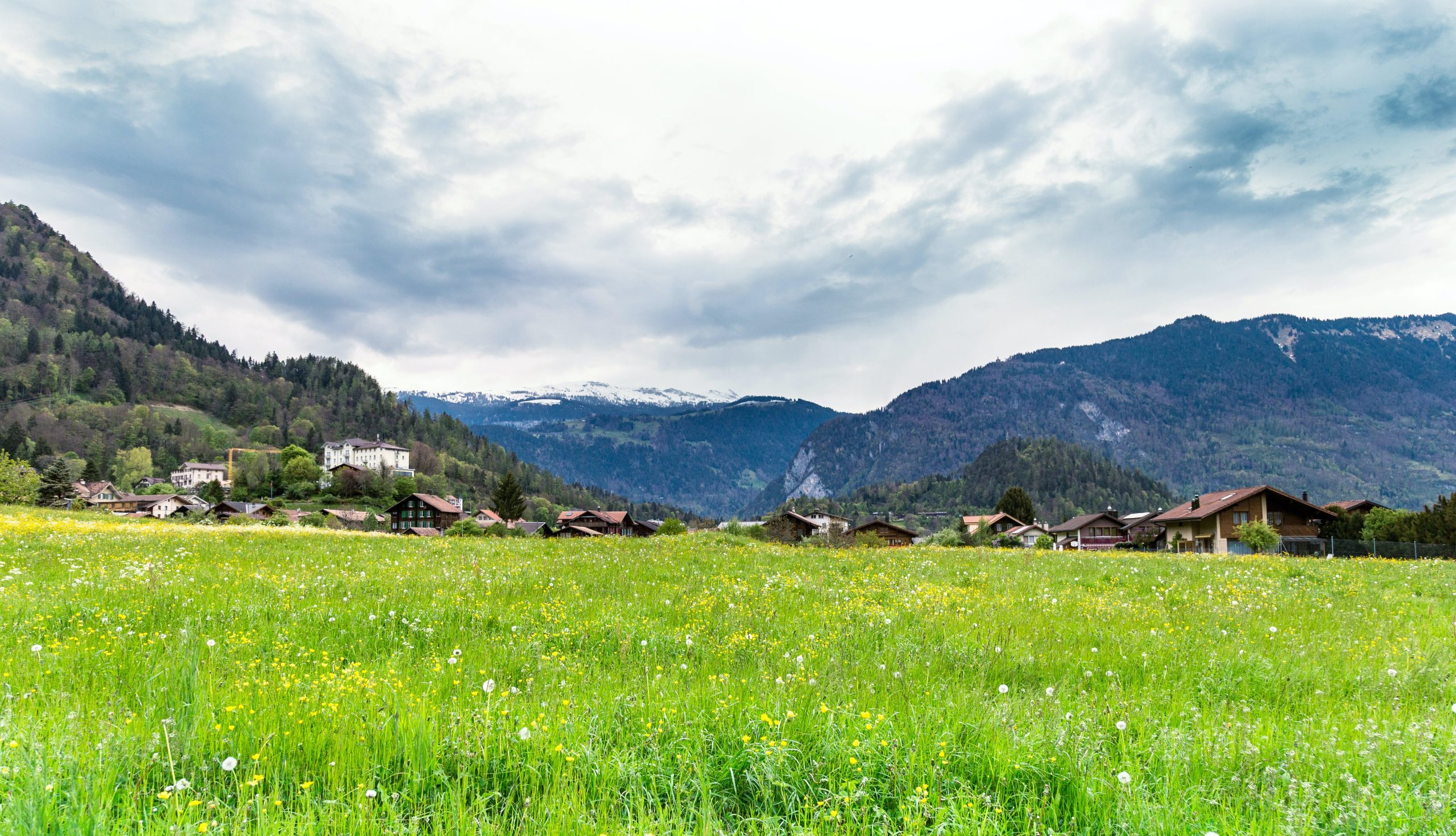
Interlaken, Switzerland, a working vacation for the Guardian in the summer of 1952, as he was preparing the launch of the Ten Year Crusade. Source: Pexels.
The Ten Year Crusade began to take shape in the Guardian’s mind long before he released its detailed provisions.
First, the Guardian had requested from different National Spiritual Assemblies the names of territories and major islands on all five continents.
Then, Shoghi Effendi added the new information to an ongoing, already extensive list of territories and islands which he had himself compiled from the list 'Abdu'l-Bahá had made in Tablets of the Divine Plan, which the Master had carefully compiled through extensive research from atlases and references books in 1916 and 1917.
Shoghi Effendi, then in a state of exhaustion and burn-out, had worked tirelessly on his own map of the goals of the Ten Year Crusade, using both sources.
Rúḥíyyih Khánum and Shoghi Effendi left the Bahá'í World Centre for a respite, in order to try to get Shoghi Effendi to regain some strength, and they traveled to a town well-known for its healing waters, so he could take a cure.
Rúḥíyyih Khánum had, with great difficulty, managed to extract a quasi-promise from the Guardian that he would rest—really rest—and devote his time for that small period to regaining his health.
The plan was that Shoghi Effendi would enjoy the pleasant summer sun, walking the long alleys of leafy trees on his way to drink a glass of healing water from the various fountains at very specific times. This should have been the ideal setting for a relaxing stay.
The Guardian spent every day pouring over his beloved map, filling in details so very meticulously. He was passionately and lovingly absorbed in his task, and didn’t listen to a word of what Rúḥíyyih Khánum or his doctors said, reminding him of his treatment, or his promise to rest. He was ploughing forward on his plans for the Ten Year Crusade.
The Bahá'í world received an inkling of what the Guardian was working on when he published his statistical pamphlet at the beginning of the Holy Year in 1952 with a supplement called "Ten Year International Teaching and Consolidation Plan,” but they were in for an extraordinary surprise.
The Guardian had prepared a set of goals for the Ten Year Crusade that was scintillating.
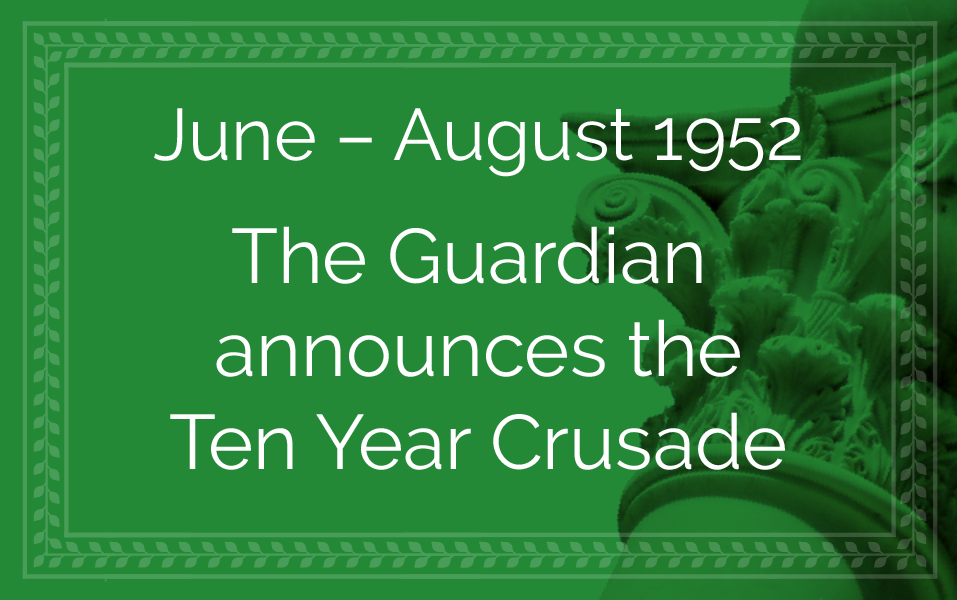

“Under whatever conditions, the dearly loved, the divinely sustained, the onward marching legions of the army of Bahá'u'lláh may be laboring, in whatever theatre they may operate, in whatever climes they may struggle, whether in the cold and inhospitable territories beyond the Arctic Circle, or in the torrid zones of both the Eastern and Western Hemispheres…” Messages to the Bahá’í World: 1950–1957, Shoghi Effendi, Bahá’í Publishing Trust, Wilmette, Illinois, 1971, page page 37, messaged dated 30 June 1952. From the arid hot deserts of the world, to its vast frozen plains, the Guardian’s personal appeal. Photo of the Arctic by Alberto Restifo on Unsplash. Photo of the Sahara Desert by Fernando Paredes Murillo on Unsplash.
The Guardian’s message of 30 June 1952 is one of his most emotional and powerful appeals, and it pierced the hearts of the Bahá'ís of the world.
The Guardian begins his impassioned plea by addressing several of the 12 National Spiritual Assemblies: the American Bahá'í Community, as the “trustees and principal executors of 'Abdu'l-Bahá’s Divine Plan,” the Iranian Bahá'ís—“long-suffering, the unflinching, the much loved and steadfast members of the venerable and still persecuted community of Bahá'u'lláh's followers”—“the small, yet intensely alive” British community, the European Bahá'ís—a “small yet virile and highly promising community”—the “newly emerged yet swiftly advancing” Canadian community, the “loyal, the assiduously laboring and highly diversified” Indian Bahá'í community, the “second most persecuted yet resolute community” in the Middle-East, the “youthful yet vigorously functioning” communities of Australia and New Zealand “the newly-fledged, spiritually alert communities of Central and South America,” and the communities in Italy and Switzerland, “as yet in the embryonic stage of their development, and who will soon take their place as an independent entity in the international Bahá'í community, and must assume their share in planting the banner of a triumphant Faith in the heart of Europe.”
Then, in a very rare instance of Shoghi Effendi using “I,” he addresses every single Bahá'í directly, young and old, of every tribe and nationality, women and men, rich or poor, Shoghi Effendi speaks to each one, addressing a plea that resonates as a cry from the Guardian’s heart:
To each and every believer, whether isolated, or associated with any local Assembly or group, who, though as yet unidentified with any specific national Plan for the systematic prosecution of this Crusade, can still, and indeed must, lend his particular assistance in this gigantic enterprise—to all, without distinction of race, nation, class, color, age or sex, I feel moved, as the fateful hour of a memorable centenary approaches, to address my plea, with all the fervor that my soul can command and all the love that my heart contains, to rededicate themselves, collectively, and individually, to the task that lies ahead of them.
The Guardian does not disguise the arduousness of the task, he faces the difficulties head-on as he lists the difficult conditions, laying out for the Bahá'ís in great detail, how difficult the Ten Year Crusade would be, telling the Bahá'ís the places they would abandon their homes to settle were some of the most inhospitable places on the planet: freezing and rugged Arctic regions, torrid deserts around the world, unbearably humid rainforests, lonely, frightfully isolated islands surrounded by thousands of miles of ocean, crassly materialistic capitals, places which were of very different faiths, penal colonies, the roof of the world in the Himalayas, the steppes of Russia or the wastes of Siberia.

Base map from Freepik.
Again, the Guardian reiterates his personal appeal to all Bahá'ís, calling them warriors:
I direct my impassioned appeal to obey, as befits His warriors, the summons of the Lord of Hosts, and prepare for that Day of Days when His victorious battalions will, to the accompaniment of hozannas from the invisible angels in the Abhá Kingdom, celebrate the hour of final victory.
The end of the Guardian’s 30 June 1952 message is where he powerfully unleashes his ability to fire the Bahá'ís, stoke their zeal, inspire them, spur them into sacrificial action, and inspire them. First, the Guardian quotes the heartbreaking words of 'Abdu'l-Bahá in the Tablets of the Divine Plan:
"O, that I could travel," ‘Abdu'l-Bahá, crying out from the depths of His soul, gives utterance to His longing, in a memorable passage, in the Tablets of the Divine Plan, addressed to the North American believers, "even though on foot and in the utmost poverty, to these regions, and raising the call of ‘Yá-Bahá'u'l-Abhá' in cities, villages, mountains, deserts and oceans, promote the Divine teachings! This, alas, I cannot do. How intensely I deplore it! Please God, ye may achieve it!"
The last paragraph of this message would be spiritual nourishment for a decade-long heroic, historic effort, punctuated by the Guardian’s longing, echoing the yearning of his own Grandfather, 'Abdu'l-Bahá, with the words “I adjure them.” At the start of a herculean 10-year spiritual Crusade, the Guardian gives the Bahá'ís hope, motivation, courage, he steels them for the tests that are surely to come, he prepares them for difficulties, calls them to never-before-seen heights of heroism. This is the Guardian, writing at his finest:
No matter how long the period that separates them from ultimate victory; however arduous the task; however formidable the exertions demanded of them; however dark the days which mankind, perplexed and sorely-tried, must, in its hour of travail, traverse; however severe the tests with which they who are to redeem its fortunes will be confronted; however afflictive the darts which their present enemies, as well as those whom Providence, will, through His mysterious dispensations raise up from within or from without, may rain upon them, however grievous the ordeal of temporary separation from the heart and nerve-center of their Faith which future unforeseeable disturbances may impose upon them, I adjure them, by the precious blood that flowed in such great profusion, by the lives of the unnumbered saints and heroes who were immolated, by the supreme, the glorious sacrifice of the Prophet-Herald of our Faith, by the tribulations which its Founder, Himself, willingly underwent, so that His Cause might live, His Order might redeem a shattered world and its glory might suffuse the entire planet—I adjure them, as this solemn hour draws nigh, to resolve never to flinch, never to hesitate, never to relax, until each and every objective in the Plans to be proclaimed, at a later date, has been fully consummated.
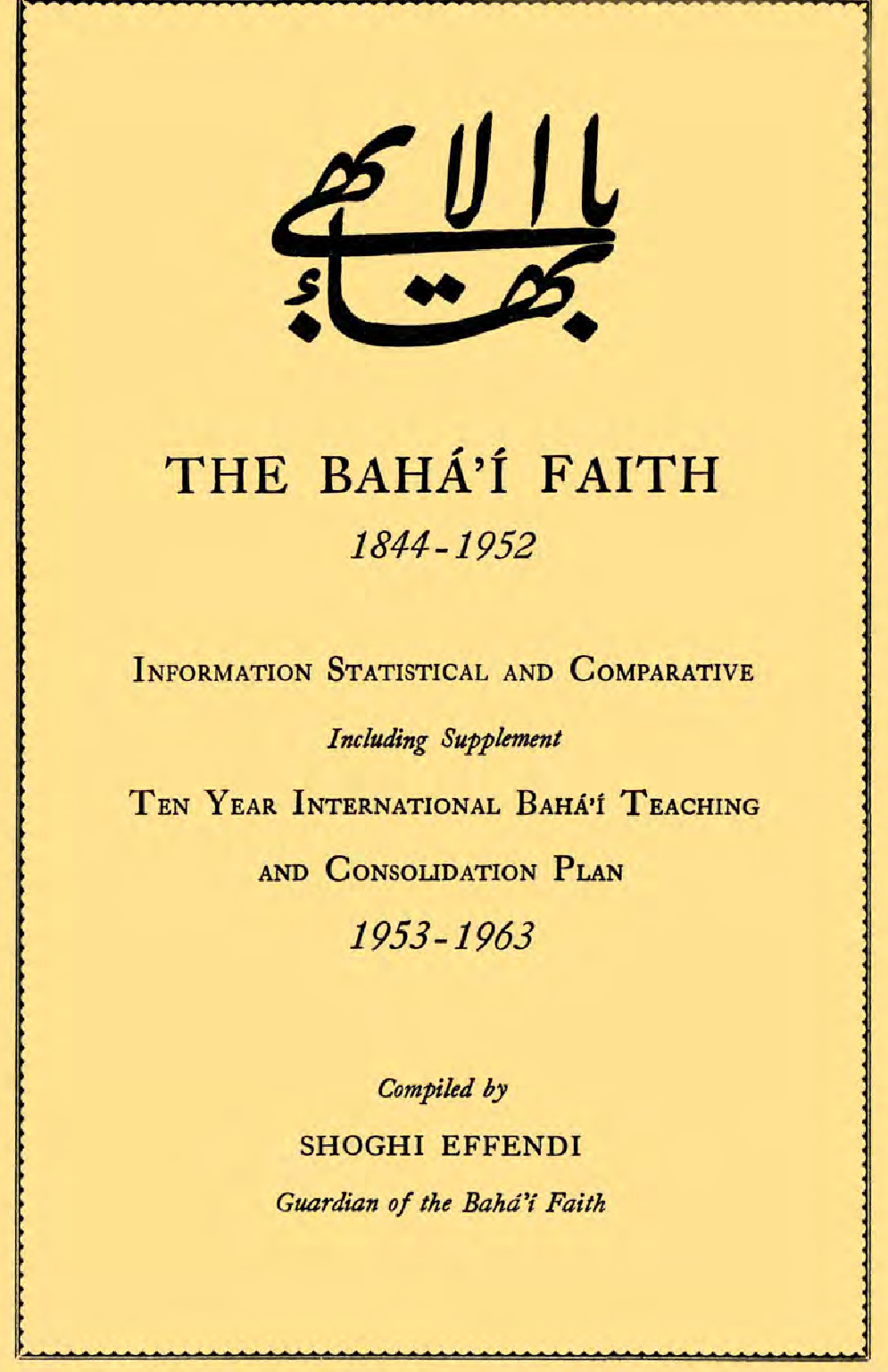
Cover of the third statistical booklet prepared by the Guardian: The Bahá'í Faith: 1844-1952: Information Statistical and Comparative.
The Guardian followed several interesting steps in sharing the Ten Year Crusade with the Bahá'ís. First, the Guardian formulated his idea for the Ten Year Crusade a year before he shared it with the Bahá'í community, while he was on his summer rest and recuperation in Switzerland. Second, he drew the map of the Ten Year Crusade with his own hands.
Third, the Guardian presented the Ten Year Crusade to the Bahá'ís—appropriately for the undisputed master of cablegram prose—through a series of cables which he sent to the National Spiritual Assemblies at the opening of the Holy Year in October 1952, in his 1953 Riḍván cable, and in his cables to the four Intercontinental Teaching Conferences held in 1953.
And fourth, in 1953, the Guardian released The Bahá'í Faith: 1844-1952: Information Statistical and Comparative, a booklet simultaneously published in London and Wilmette, and which he compiled himself which included maps and the details of the Ten Year Crusade along with every possible Bahá'í statistic and historical fact imaginable. See the next story about this statistical booklet.
Beginning in 1944, the Guardian published the first of his statistical booklets, veritable works of statistical art. The first one—26 pages long—was called A World Survey of the Bahá'í Faith: 1844 - 1944. Six years later, Shoghi Effendi published the second version, with a new, and more descriptive title, The Bahá'í Faith: 1844-1950: Information Statistical and Comparative—this pamphlet was 35 pages long.
In 1953, ahead of the launch of the Ten Year Crusade, Shoghi Effendi published his third and final statistical booklet called The Bahá'í Faith: 1844-1952: Information Statistical and Comparative, the longest of all his previous statistical compilation weighing in at 74 pages, more than double the length of his previous one, only three years earlier.
Below is a summary of the contents of this majestic, elegant and extremely useful booklet, which the Guardian divided in two sections: Information Statistical and Comparative and Ten Year International Bahá’í Teaching and Consolidation Plan 1953 – 1963:
Information Statistical and Comparative
- Dates of Historical Significance 1844 – 1952
- Countries Opened to the Faith of Baha'u'llah 1944 – 1952
- Languages in which Bahá’í Literature has been Translated and Printed
- Languages in which Bahá’í Literature is being Translated
- List of the Báb's Best-Known Writings
- Alphabetical List of Baha'u'llah's Best-Known Writings
- Races Represented in the Bahá’í World Community
- Minority Groups and Races with which Contact has been Established by Bahá’ís
- African Tribes Represented in the Bahá’í Faith
- Recently Appointed Hands of the Cause
- Bahá’í National Spiritual Assemblies Already Established
- National Spiritual Assembly in Process of Formation
- Bahá’í National Administrative Headquarters (Ḥaẓíratu’l-Quds) in East and West
- Incorporated Bahá’í Assemblies – National Spiritual Assemblies
- Incorporated Bahá’í Assemblies – Local Spiritual Assemblies
- Territories, Federal Districts and States of the United States of America where Bahá’í Marriage Certificates are Recognized
- Territories in the Middle East where Bahá’í Marriage Certificates are Recognized
- Countries, States and Cities where Bahá’í Holy Days are Recognized
- Data Concerning Important National and International Bahá’í Endowments
- Principal Bahá’í Historic Sites in Persia Owned by the Bahá’í Community
- American National Bahá’í Endowments
- Estimated Value of American Bahá’í Properties
- Successive Stages in the Transfer of the Remains of the Báb from Persia to the Holy Land and the Erection of His Mausoleum on Mount Carmel
- Names Given by 'Abdu'l-Bahá to Five of the Doors of the Shrine of the Báb on Mt. Carmel
- Names of the Three Doors Added Since the Passing of ‘Abdu’l-Bahá
- Fate of Those Who Persecuted the Báb, Who Opposed the Construction of His Shrine and Threatened Its Destruction
- Data Regarding the Bahá’í Temple in Wilmette, Illinois
- Passages Inscribed Over the Nine Entrances of the Bahá’í Temple Wilmette, Illinois, U.S.A.
- Passages Inscribed in the Interior of the Bahá’í Temple - Wilmette, Illinois, U.S.A
- Comparative Measurements of Famous Domed Structures
- Localities Where Bahá’ís Reside in the United States of America
- Localities Where Bahá’ís Reside in Persia
- Bahá’í Centers in Latin America and the Antilles - Central America and the Antilles
- Bahá’í Centers in Latin America and the Antilles - South America
- Bahá’í Centers in India, Pakistan and Burma
- Bahá’í Centers in Canada
- Bahá’í Centers in Australia, New Zealand and Tasmania
- Bahá’í Centers in Germany and Austria
- Bahá’í Centers in the British Isles
- Bahá’í Centers in the Ten European Countries Opened to the Faith by the American Bahá’í Community Under the Second Seven-Year Plan, 1946 – 1953
- Bahá’í Centers in Egypt and the Sudan
- Bahá’í Centers in Territories of Arabia
- Approximate Number of Localities where Bahá’ís Reside in Leading Bahá’í Communities Throughout the World
- The Badi' or Bahá’í Calendar
- Bahá’í Feasts, Anniversaries and Days of Fasting
- Bahá’í Holy Days on which Work Should be Suspended
- Chronological List of Significant Events Related to Baha'u'llah's Historic Pronouncement in His Súriy-i-Mulúk in 1963
- Stages in Baha'u'llah's Successive Exiles from Ṭihrán to 'Akká
- Cities Visited by 'Abdu'l-Baha in the Course of His Three-Year Travels – 1911 – 1913
- List of Centers in Greenland where Bahá’í Literature has been Sent
- Prominent Personages Who Have Paid Tribute to the Bahá’í Faith
Ten Year International Bahá’í Teaching and Consolidation Plan 1953 – 1963
- Objectives of the Ten Year Plan to be Conducted by Twelve Bahá’í National Assemblies
- Territories Mentioned by 'Abdu'l-Baha in the Tablets of the Divine Plan
- Alphabetical List of Territories to be Opened to the Faith, Showing Allocation to National Spiritual Assemblies
- Territories to be Opened to the Faith. Division of Activities According to Continents
- Territories to be Opened to the Faith. Division of Activities According to National Spiritual Assemblies
- Alphabetical List of Languages into which Bahá’í Literature is to be Translated
- Languages in which Bahá’í Literature is to be Translated. Listed According to Continents
- Objectives of the Ten Year Plan at the World Center of the Faith in Israel
- Territories Already Opened to the Faith, Allocated to Bahá’í National Spiritual Assemblies for Consolidation
- Consolidation of the Faith in Territories Included within its Pale as of . Allocation According to National Spiritual Assemblies
- Location of Sites for Future Bahá’í Temples to be Acquired
- Cities in which Bahá’í Temples are to be Constructed
- Alphabetical List of Countries in which Bahá’í National Spiritual Assemblies are to be Established
- Countries in which Bahá’í Regional National Spiritual Assemblies are to be Established
- National Spiritual Assemblies to be Established. Division According to Continents
- Alphabetical List of Bahá’í National Spiritual Assemblies to be Incorporated
- Alphabetical List of Bahá’í National Spiritual Assemblies which are to Establish Bahá’í National Endowments
- Localities in which National Ḥaẓíratu’l-Quds to be Established
- National Bahá’í Courts to be Established
- National Spiritual Assemblies which are to Establish Branches in Israel
- Localities in which Bahá’í Publishing Trusts are to be Founded
- List of Republics Constituting the Union of Soviet Socialist Republics
- Countries Within Orbit of the Soviet Union
- Countries whose National Assemblies are to Participate in the Introduction of the Faith in the Soviet Union
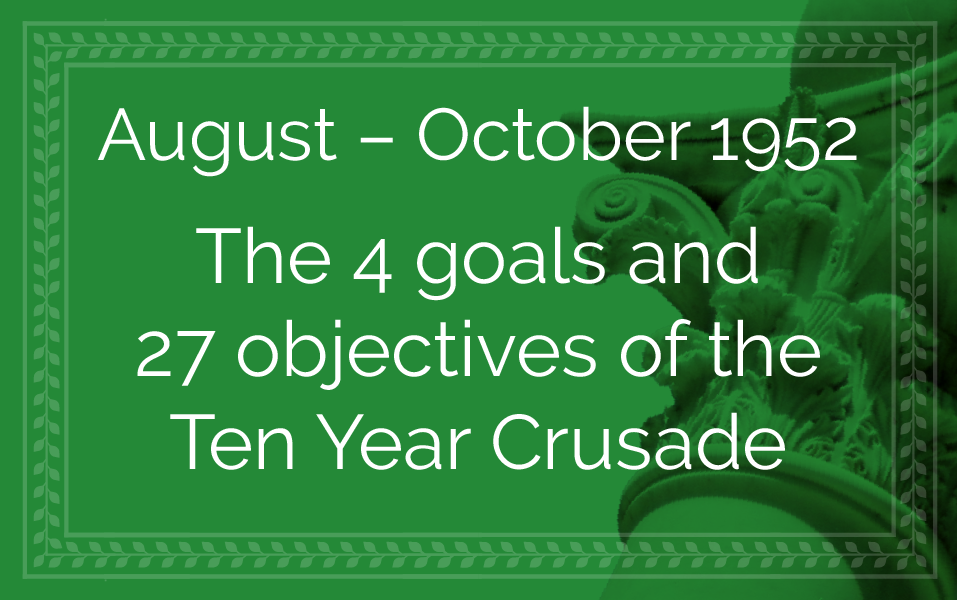
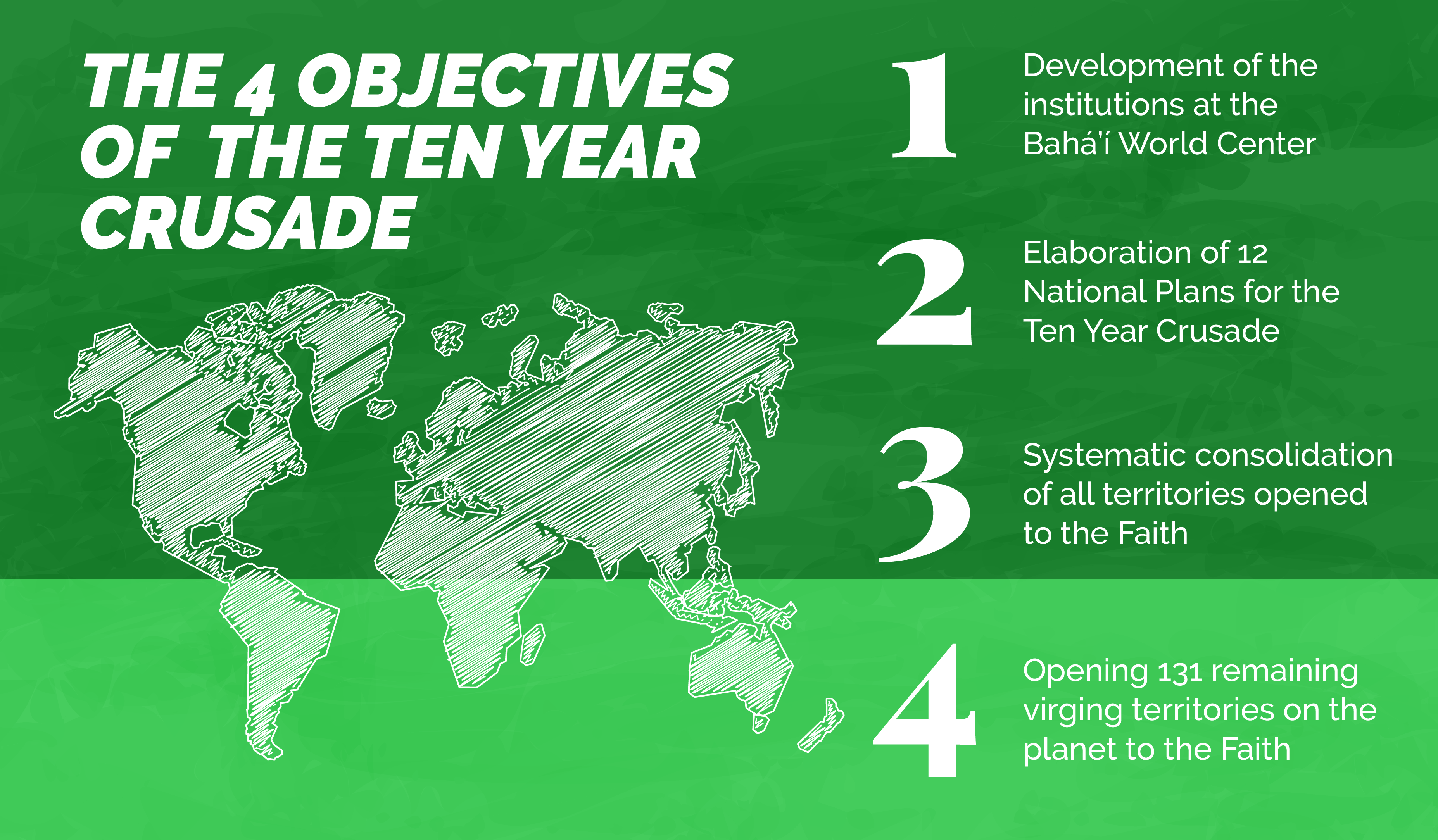
The 4 objectives of the Ten Year Crusade. Graphic created on a map designed by Freepik.
On 5 August 1952, the Guardian sent an electrifying message to the Bahá'í World in the form of a cable titled “Launching the World-Embracing Spiritual Crusade” which opened with a great vision of the four Intercontinental Teaching Conferences which were to launch the Ten Year Crusade, a decade-long endeavor that would eclipse in its brilliant and historic achievements the past hundred years of victories:
Feel hour propitious to proclaim to the entire Bahá'í world the projected launching on the occasion of the convocation of the approaching Intercontinental Conferences on the four continents of the globe the fate-laden, soul-stirring, decade-long, world-embracing Spiritual Crusade…
In this cable, Shoghi Effendi sets out the four objectives of the Ten Year Crusade which would mark the third and last phase of the first epoch in implementing 'Abdu'l-Bahá’s Divine Plan:
- The first objective was the development of the institutions at the Bahá'í World Centre.
- The second objective was the elaboration of 12 national plans for the Ten Year Crusade, one for each of the 12 National Spiritual Assemblies.
- The third objective was systematic consolidation of all the territories opened to the Faith by 1953.
- The fourth objective was the opening of all remaining virgin territories on the planet to the Bahá'í Faith. All of these carefully identified territories would be specifically assigned to each functioning National Spiritual Assembly in the world.
Of the four goals, the most urgent was the last one, the opening of 131 new virgin territories to the Faith. The Guardian emphasized that what was urgently needed was “immediate, determined, sustained, universal” dispersal throughout the unopened territories. Leroy Ioas asked the Guardian about the great sense of urgency in the dispersal of Bahá'ís throughout the planet, and the Guardian responded:
We must build lighthouses of the Faith through which the Holy Spirit may descend. When the people enter in flocks, if there are ten centers, they will become a hundred. We are making new doorways for the people to enter the Kingdom of God.

The Guardian’s beloved Zermatt by night. Photo by Explore with Joshua on Unsplash.
The Guardian had conceived of the Ten Year Crusade while he was in Switzerland, and when he returned with Rúḥíyyih Khánum, Leroy Ioas picked them up from the airport and riding with them to Haifa, immediately sensing a new energy about the Guardian, saying he was “speaking in a different vein.”
Leroy Ioas could instantly feel that something momentous, a turning point in the history of the Faith was at hand. That evening, when the Guardian came down for dinner, he was very happy and enthusiastic, and said:
I have been very busy this summer. I have worked out a teaching program for the Baha'is of the world. I would like to tell you about it and see what you think.
After outlining the Ten Year Crusade with dazzling and forceful clarity, the Guardian asked:
Well, what do you think?
Everyone seated around the table was overwhelmed, they didn’t know what to think. So Shoghi Effendi reiterated the various components of the Ten Year Crusade and asked Leroy Ioas which of these objectives would be the easiest to attain. Leroy Ioas answered:
I believe the easiest will be to establish the Faith in those one hundred and thirty-one new countries. To be the first Baha'i in a new place is glamorous and you're going to have many people immediately wanting to do that.
The Guardian asked Leroy Ioas:
What do you think will be more difficult?
More difficult, will be raising all the money you need; the Baha'is hold on to their money too long.
And what will be the most difficult?
The consolidation work you have outlined, Shoghi Effendi, because that is drudgery, just plain drudgery, right on the home front where there's no glory associated with it; that is going to be hard.
The Guardian said:
I agree with you, I think it will be like that.
Two months later, on 8 October 1952 the Guardian had launched the Ten Year Crusade:
Feel hour propitious to proclaim to the entire Bahá’í World the projected launching…the fate-laden, soul-stirring, decade-long, world-embracing Spiritual Crusade…
The Guardian loved maps and drew one that showed the elements of all the 12 national plans, showing at a glance in infographic form, how the National Spiritual Assemblies were working together, crossing boundaries, united in the same effort. The Guardian tasked Leroy Ioas—a man legendary for his meticulousness—to keep detailed lists of all the pioneer goals as they were settled, and that meant he sometimes had to write letters to ascertain who had accompanied a Knight of Bahá'u'lláh to a location.
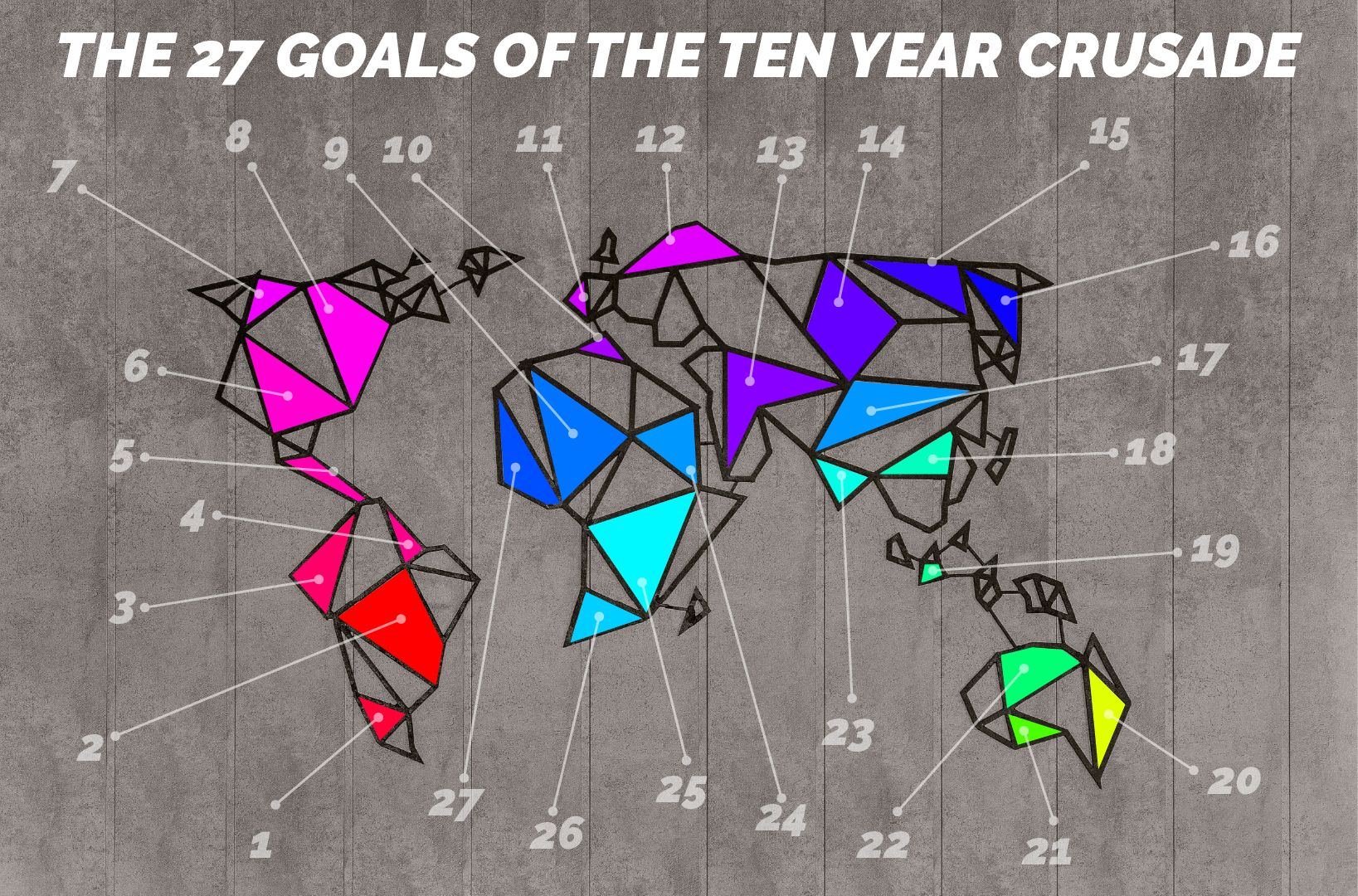
There was too much text in the list of the 27 goals for the Ten Year Crusade to create an infographic, so this piece of art is just a symbolic representation of the goals of the Crusade, and not country-specific. Original photo by Marjan Blan on Unsplash.
The Ten Year Crusade’s four overarching objectives were the architecture of the vision for the next decade of the Bahá'í communities life, but the Guardian was an extraordinary leader, and he also provided 27 concrete, specific, numerical goals for the Bahá'ís, who would go on to achieve heroic feats, to hold on to.
We have broken down these goals into thematic groupings.
The development of the institutions at the Bahá'í World Centre:
- Adopting preliminary measures for the construction of Bahá'u'lláh's permanent Shrine in the Holy Land.
- Purchasing land for a House of Worship in the Holy Land
- Extending the endowments of the Faith at the Bahá'í World Centre
- Building the International Bahá'í Archives
- Establishing a Bahá'í Court in the Holy Land as a preliminary to the emergence of the Universal House of Justice.
- Doubling the number of countries in which the Bahá'í Faith is established, focusing on the remaining Virgin territories specifically mentioned by 'Abdu'l-Bahá in the Tablets of the Divine Plan
- Establishing seven Israel Branches of selected National Spiritual Assemblies
- Reinforcing the ties between the international Bahá'í community and the United Nations
The Kitáb-i-Aqdas
- The codification of the laws and ordinances of the Kitáb-i-Aqdas
National Spiritual Assemblies
- Quadruple the number of National Spiritual Assemblies
- Multiply seven-fold the number of national Bahá'í centers
- Framing national Bahá'í constitutions
- Establishing national Bahá'í endowments in capitals where national Bahá'í constitutions exist
- More than quintuple the number of incorporated National Assemblies
- The establishment of six national Bahá'í courts
- As far as circumstances permit, including 11 republics of the Soviet Union within the Administrative Order of the Faith
Houses of Worship
- Doubling the number of Houses of Worship
- Purchasing land for 11 future Houses of Worship
- Erecting the first dependency of the House of Worship in North America
Holy Places and resting places in Iran and Iraq
- Erecting a tomb for Khadíjih Bagum, the wife of the Báb in Shíráz, identifying the resting places of Bahá'u'lláh’s father, Mirza Buzurg, of Fáṭimih Bagum, the mother of the Báb, and of His cousin for re-interment in the Bahá'í cemetery near the Most Great House in Baghdad.
- Purchasing the Garden of Riḍván in Baghdad, the Siyáh-Chál in Ṭihrán, the site of the Báb’s martyrdom at the barracks square in Tabriz and the castle of Chihríq, the place of the Báb’s last incarceration
The appointed arm of the Bahá'í Administration
- Developing the function of the Institution of the Hands of the Cause
- By Riḍván 1954, the 15 Hands of the Cause from 5 continents will appoint the very first continental auxiliary boards, composed of 9 Auxiliary Board Members, one board for each of the four continents.
Goals for Iran
- Increase the participation of the women of Iran in the membership of national and local Assemblies.
- Establishing a printing press in Iran.
Bahá'í literature
- Doubling the number of languages in which Bahá'í literature is translated
World Congress in Baghdad
- Assemble a World Bahá'í Congress in the vicinity of the Garden of Ridván, Baghdád, the third holiest city in the Bahá'í world, on the occasion of the world-wide celebrations of the Most Great Jubilee, commemorating the Centenary of the Ascension of Bahá'u'lláh to the Throne of His Sovereignty.
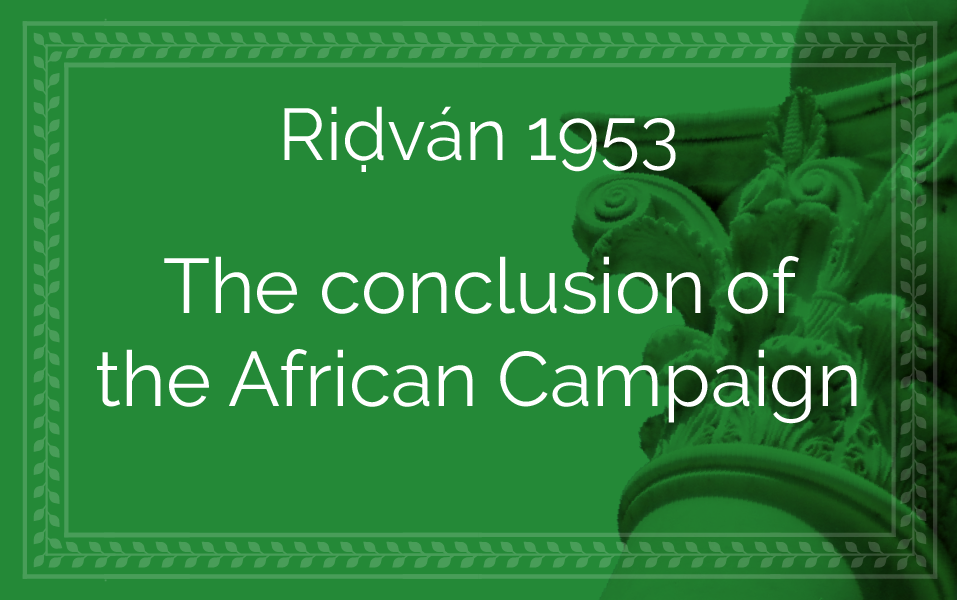
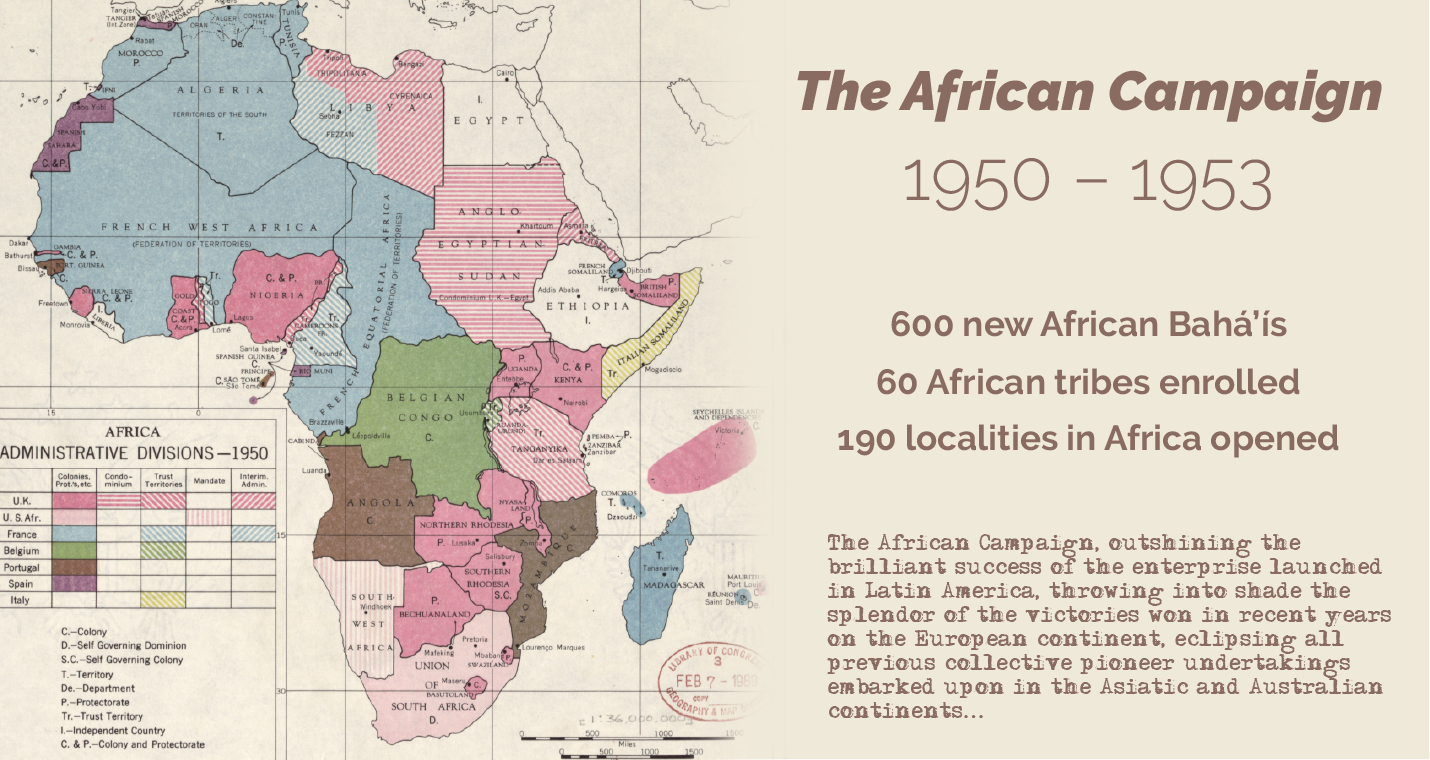
Map of the administrative divisions of Africa, created in 1950 by the Central Intelligence Agency. Source: Library of Congress.
By the conclusion of the African Campaign, the Guardian’s goals had been achieved:
- There were now 600 African Bahá'ís
- 60 tribes had been enrolled into the Faith
- And the Bahá'í Faith was present in 190 localities on the African continent
At the conclusion of the African Campaign, the Guardian expressed his pride at its achievements in two communications, first in his Riḍván message of 1954:
The African Campaign, outshining the brilliant success of the enterprise launched in Latin America, throwing into shade the splendor of the victories won in recent years on the European continent, eclipsing all previous collective pioneer undertakings embarked upon in the Asiatic and Australian continents…
And six months later, in a letter dated 1 October 1954:
The phenomenal progress of the African Campaign, alike in the teaching and administrative spheres of Bahá'í activity, has been maintained, most conspicuously in the heart of that continent, as evidenced by the ever-swelling number of African converts…
The ground was laid for the Ten Year Crusade.

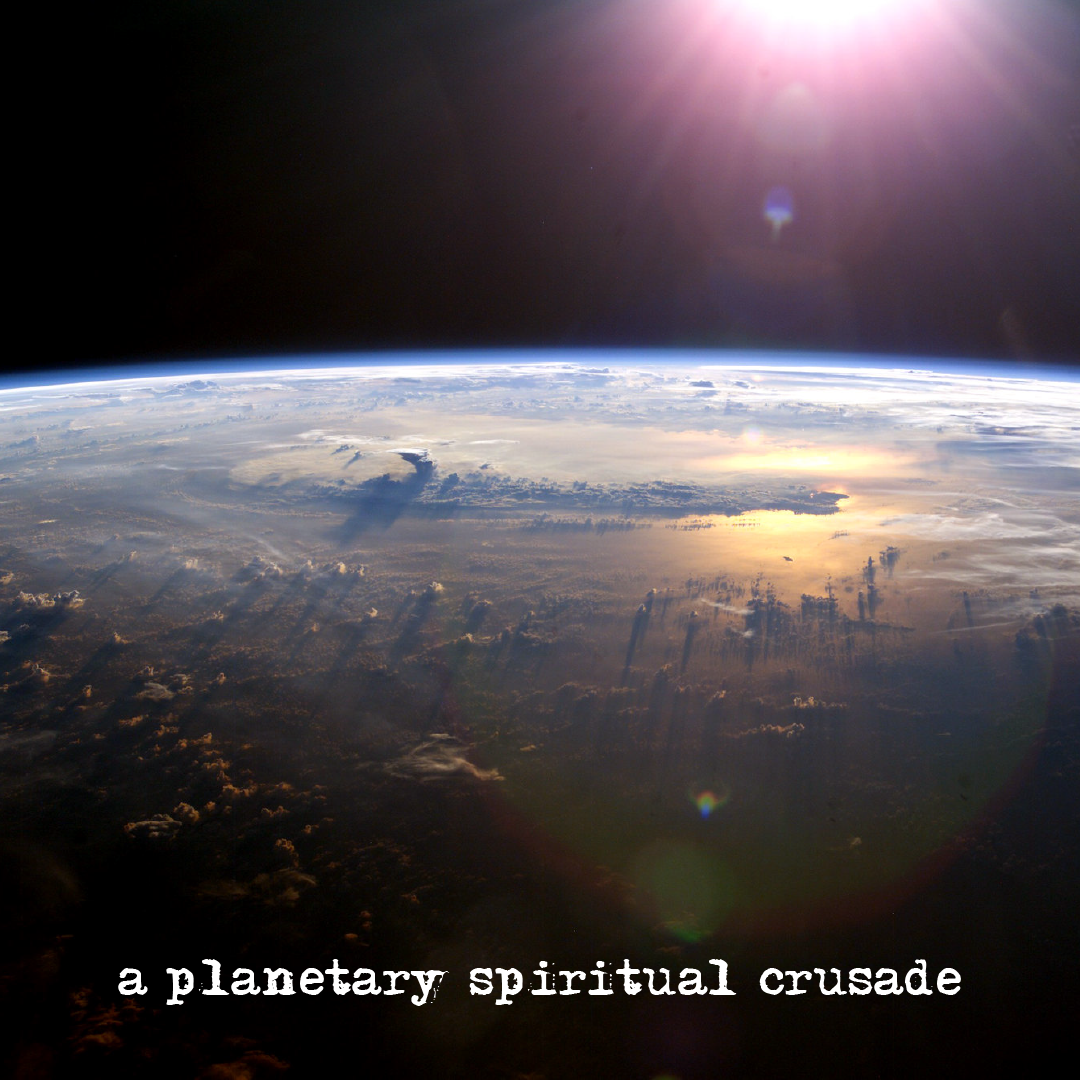
Background image of planet earth by NASA.
Before setting forth the goals and aims of the Guardian’s Ten Year Crusade, it is vital to understand that it was not just another teaching plan. The Ten Year Crusade is, in fact, the accomplishment of 6,000 years of religious evolution, the ninth stage and the culmination of a process begun six millennia prior.
In a letter written on 4 May 1953, the Guardian sets forth all ten stages of this process, but begins with an explosion of majesty, in describing the meaning and scope of the crusade, which the Guardian calls “a planetary spiritual crusade”:
Let there be no mistake. The avowed, the primary aim of this Spiritual Crusade is none other than the conquest of the citadels of men's hearts. The theater of its operations is the entire planet. Its duration a whole decade. Its commencement synchronizes with the centenary of the birth of Bahá'u'lláh's Mission. Its culmination will coincide with the centenary of the declaration of that same Mission.
The Guardian announces that by 1963, this immense, majestic ten-stage religious process begun with the Adamic Cycle six thousand years ago, would be complete.
Hail, with feelings of humble thankfulness and unbounded joy, opening of the Holy Year commemorating the centenary of the rise of the Orb of Bahá'u'lláh's most sublime Revelation marking the consummation of the six thousand year cycle ushered in by Adam, glorified by all past prophets and sealed with the blood of the Author of the Bábí Dispensation. Evoke on this auspicious occasion the glorious memory and acclaim the immortal exploits of the Dawn-Breakers of the Apostolic Age of the Bahá'í Dispensation in the cradle of the Faith and the mighty feats of the champion builders.
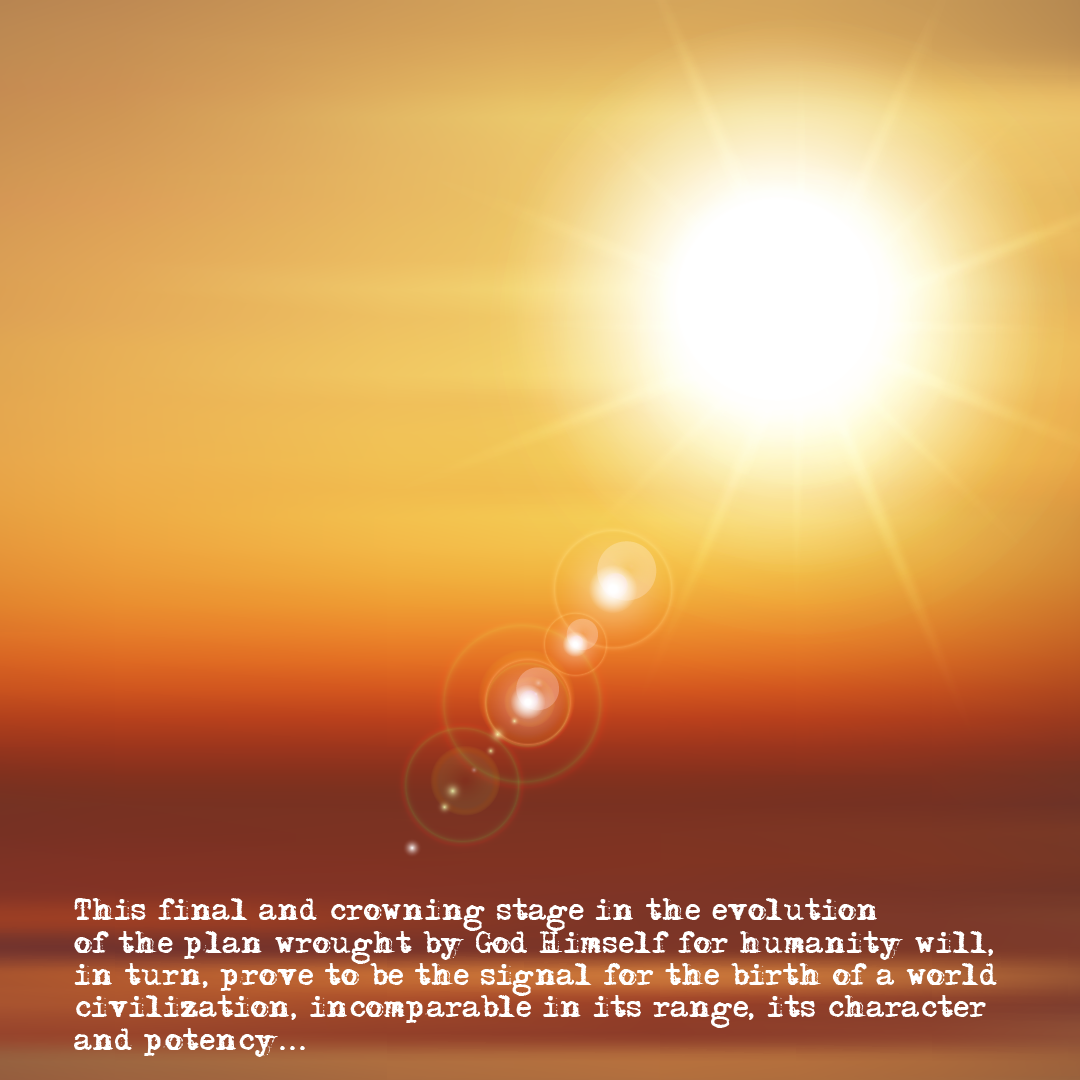
Background from Freepik.
Below are the ten stage of the 6-millennia-long religious process as explained by Shoghi Effendi in his 4 May 1953 letter to the Bahá'í World in the section titled “Begin ninth part of majestic process”:
- The first stage of the process was the growth of the tree of Divine Revelation through the Dispensations of Moses, Zoroaster, Buddha, Jesus, Muhammad and other Prophets.
- The second stage of this age-long process was the Declaration of the Báb’s Mission.
- The third stage was the Dispensation of the Báb, ending with His martyrdom.
- The fourth part of the process was the Revelation received by Bahá'u'lláh in the Siyáh-Chál.
- The fifth stage was the period of Bahá'u'lláh’s first exile in Iraq.
- The sixth stage of the process was Bahá'u'lláh’s exiles to Edirne, the Most Great Prison, and 'Akká, from where His Faith spread to 13 countries.
- The seventh stage was the ministry of 'Abdu'l-Bahá, which saw the spread of Bahá'u'lláh’s Cause to 20 sovereign states and dependencies in Europe, America, and Australia.
- The eighth stage of this process took place in the opening years of the second epoch of the Formative age by the year 1953, under Shoghi Effendi’s Guardianship, when the Faith reached 94 countries, dependencies and islands as a result of plans by 12 National Spiritual Assemblies, and a robust and growing Bahá'í Administrative Order. This eighth stage ended with the centenary of Bahá'u'lláh’s Revelation.
- The ninth stage was the Ten Year Crusade. This was the threshold the Bahá'í community was now standing on the edge of, about to cross into religious history. The aims and goals of this world-embracing crusade will be discussed in the next part. The Guardian states that this ninth part of the process was to end in 1963, with the centenary of Bahá'u'lláh’s Declaration in Baghdad.
- Lastly, the tenth and last stage, culminating, millennia-long concluding part of this spiritual process was the spread of the Bahá'í Faith in every single remaining corner of the earth, over the course of many plans, crusades, and epochs of the Formative and Golden ages of the Faith, until the light of Bahá'u'lláh’s loving and protective Faith envelops the entire planet. This is how the Guardian speaks of the final stage of this spiritual process:
This final and crowning stage in the evolution of the plan wrought by God Himself for humanity will, in turn, prove to be the signal for the birth of a world civilization, incomparable in its range, its character and potency, in the history of mankind—a civilization which posterity will, with one voice, acclaim as the fairest fruit of the Golden Age of the Dispensation of Bahá'u'lláh, and whose rich harvest will be garnered during future dispensations destined to succeed one another in the course of the five thousand century Bahá'í Cycle.

Background map by Freepik.
Shoghi Effendi was extremely organized in anything he undertook, the Ten Year Crusade included.
When he implemented the Ten Year Crusade, the Guardian divided the first 5 years of the Crusade from 1953 to 1958 into three phases:
- The first phase was from Riḍván 1953 to Riḍván 1954
- The second phase spanned Riḍván 1954 to Riḍván 1956
- The third phase went from Riḍván 1956 to Riḍván 1958
The second five years of the Plan were to span from Riḍván 1958 to Riḍván 1963—set to end at the Centenary of the Declaration of Bahá'u'lláh—and would be focused on completing the rest of the vital objectives assigned by him under the Plan.
The first phase was a one year expansion phase and the second and third phases were two consolidating phases. The descriptions of each phase can be found at the end date point for each phase: for the first phase at Riḍván 1954, second phase at Riḍván 1956, etc.
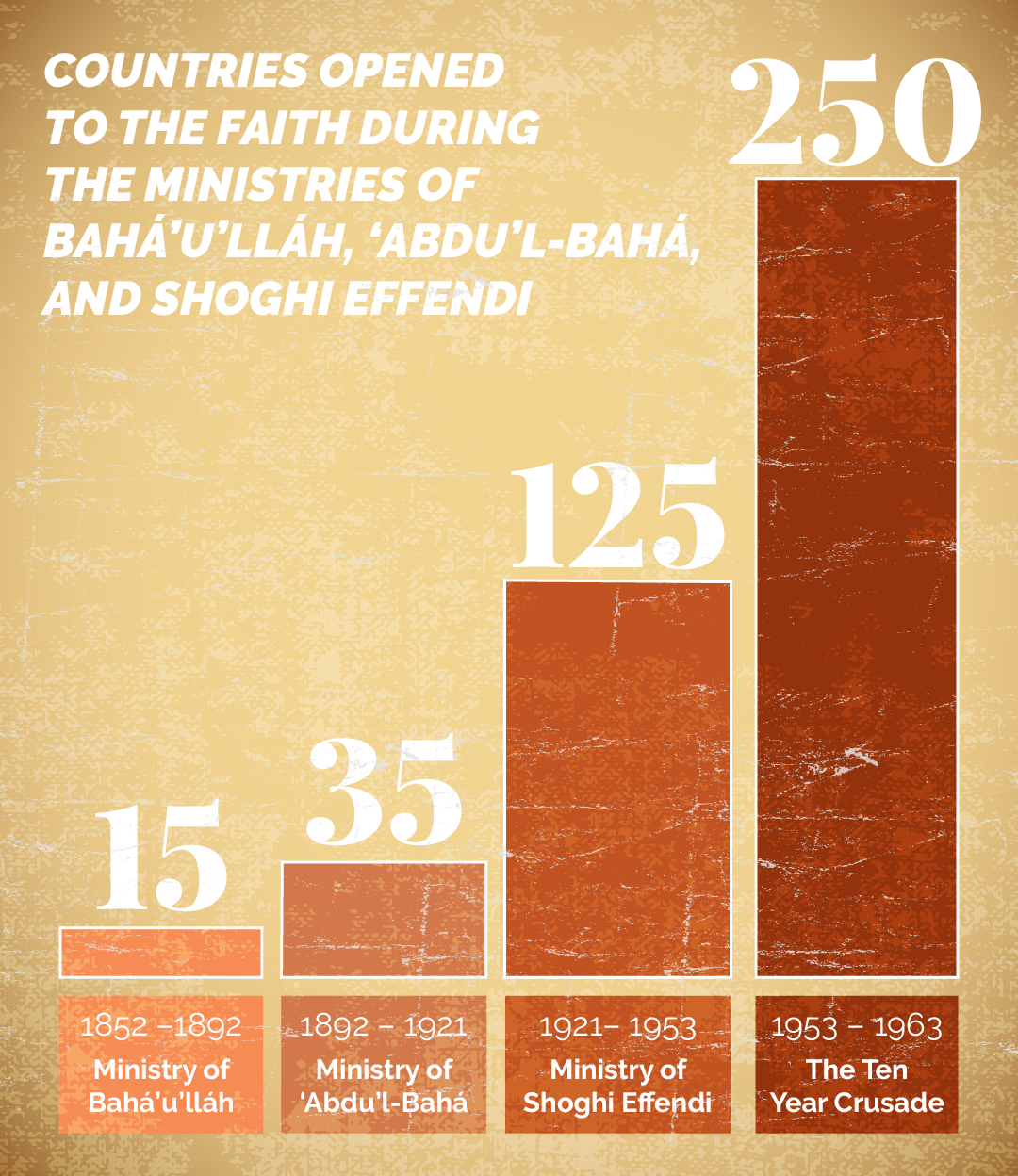
Countries opened to the Bahá'í Faith during the ministries of Bahá'u'lláh, 'Abdu'l-Bahá, and Shoghi Effendi. Bar graph asset from Freepik.
The immediate goal of the National Spiritual Assemblies was the spread of the Faith of Bahá'u'lláh to every sovereign nation, principal dependency, territory and Crown colony over the surface of the planet. As Rúḥíyyih Khánum described it brilliantly in a single sentence:
Shoghi Effendi lifted the curtain on the arena of the new Plan: Where? Why, everywhere…To whom? Why, to all peoples…
The Guardian once said that if it had been a human plan, the Ten Year Crusade would have been an idle dream, but it was far from a human dream. He described it as a stage in the Plan of God given through 'Abdu'l-Bahá, through which the peoples of the world were receiving the Glad Tidings of Bahá'u'lláh.
In the brief 6 years of the Bab's Dispensation, the Faith was known in only two countries—Persia and Iraq in Ottoman Empire. During. Bahá'u'lláh’s lifetime, the Faith had spread to 15 countries. By the time of 'Abdu'l-Bahá’s Ascension, there were 35 countries opened to the Faith. During the first 30 years of the Guardian’s ministry, the Faith had spread to 128 countries, and with the Ten Year Crusade, he intended it to reach double the number of countries. It was a gargantuan task, and Guardian was well aware of it, stating:
The next ten years must see feats eclipsing all the pioneering feats of the previous one hundred and ten years.
As reports came in to Haifa of victories in the remotest corners of the earth, Shoghi Effendi often told this story of the joy of Bahá'u'lláh while he was living in Iraq in 1856 – 1863 that the Faith had spread hundreds of kilometers north of Baghdad.
A Bábí named Ílkhání reached Díyárbakr, 640 kilometers from Baghdád, and wrote a letter of introduction to Bahá'u'lláh for two Armenian merchants addressing the letter “To His Eminence Bahá’u’lláh, Leader of the Bábís.”
The Armenian merchants presented their letter of introduction to Bahá'u'lláh, explaining to Him that the Ílkhání had taught them the Bábí Faith. Bahá'u'lláh later entered the family apartments of the Most Great House and cried out to His brother Mírzá Músá, smiling and triumphant:
Kalím, Kalím! The fame of the Cause of God has reached as far as Díyárbakr!
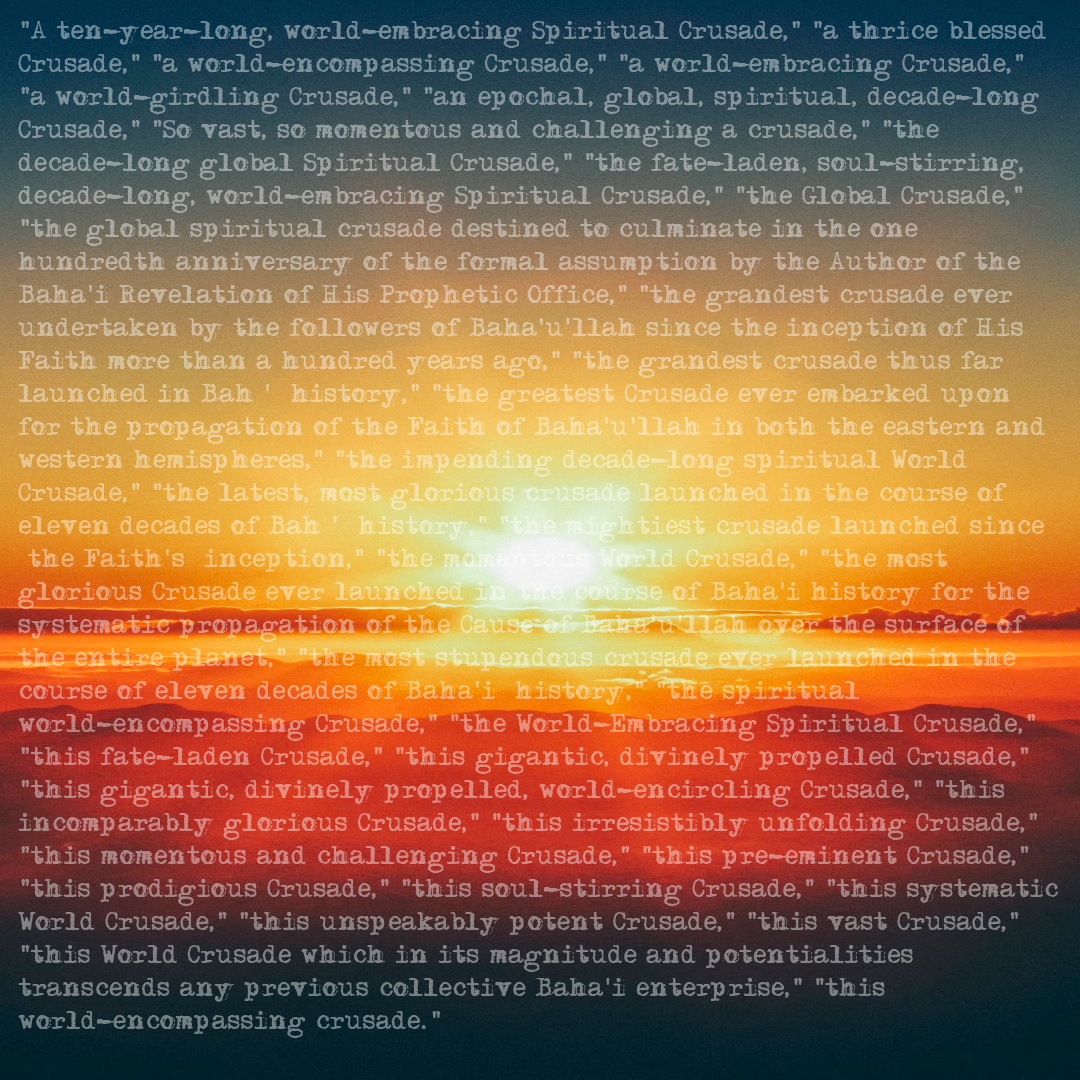
All the terms listed in the story below over the stunning photograph of a glorious sunrise. Background image by Jonathan Borba on Unsplash.
The Guardian’s passion for the English languages is a wonderful guide for us to study what it was he was most passionate about. The exalted language in which the Guardian speaks of the Ten Year Crusade, the heights of literary poetry that he reaches in describing this decade-long endeavor are pure gems, the most exquisite emanations of his poetic mind.
This section, based on ‘Alí Nakhjávání’s marvelous findings in his 22nd Ḥasan Balyúzí Memorial Lecture entitled The Ten Year Crusade, is an homage to both the Guardian and one of his most able generals, the inimitable, unforgettable, ‘Alí Nakhjávání—the list has been greatly augmented with additional findings.
The Guardian described the Ten Year Crusade with a variety of beautiful soul-uplifting titles that he conferred upon this Crusade, amply demonstrating the importance he attached to this spiritual enterprise:
- “a ten-year-long, world-embracing Spiritual Crusade”
- “a thrice blessed Crusade”
- “a world-encompassing Crusade”
- “a world-embracing Crusade,”
- “a world-girdling Crusade”
- “an epochal, global, spiritual, decade-long Crusade”
- “So vast, so momentous and challenging a crusade”
- “the decade-long global Spiritual Crusade”
- “the fate-laden, soul-stirring, decade-long, world-embracing Spiritual Crusade”
- “the Global Crusade”
- “the global spiritual crusade destined to culminate in the one hundredth anniversary of the formal assumption by the Author of the Bahá'í Revelation of His Prophetic Office”
- “the grandest crusade ever undertaken by the followers of Bahá'u'lláh since the inception of His Faith more than a hundred years ago”
- “the grandest crusade thus far launched in Bahá'í history”
- “the greatest Crusade ever embarked upon for the propagation of the Faith of Bahá'u'lláh in both the eastern and western hemispheres”
- “the impending decade-long spiritual World Crusade”
- “the latest, most glorious crusade launched in the course of eleven decades of Bahá'í history”
- “the mightiest crusade launched since [the Faith’s] inception”
- “the momentous World Crusade”
- “the most glorious Crusade ever launched in the course of Bahá'í history for the systematic propagation of the Cause of Bahá'u'lláh over the surface of the entire planet”
- “the most stupendous crusade ever launched in the course of eleven decades of Bahá'í history”
- “the spiritual world-encompassing Crusade”
- “the World-Embracing Spiritual Crusade”
- “this fate-laden Crusade”
- “this gigantic, divinely propelled Crusade”
- “this gigantic, divinely propelled, world-encircling Crusade”
- “this incomparably glorious Crusade”
- “this irresistibly unfolding Crusade”
- “this momentous and challenging Crusade”
- “this pre-eminent Crusade
- “this prodigious Crusade
- “this soul-stirring Crusade”
- “this systematic World Crusade”
- “this unspeakably potent Crusade
- “this vast Crusade”
- “this World Crusade which in its magnitude and potentialities transcends any previous collective Bahá’í enterprise”
Shoghi Effendi continued to send inspirational messages in both Persian and English, reminding the worldwide Bahá'í community of the uniquely majestic and infinitely glorious characteristics of the Ten Year Crusade. Below is a fervent passage from the Guardian’s 4 May 1953, a perfect illustration of how inspiring the Guardian was:
The agencies assisting in [the conduct of this Spiritual Crusade] are the nascent administrative institutions of a steadily evolving divinely appointed order. Its driving force is the energizing influence generated by the Revelation heralded by the Báb and proclaimed by Bahá’u’lláh. Its Marshal is none other than the Author of the Divine Plan. Its standard-bearers are the Hands of the Cause of God appointed in every continent of the globe. Its generals are the twelve national spiritual assemblies participating in the execution.

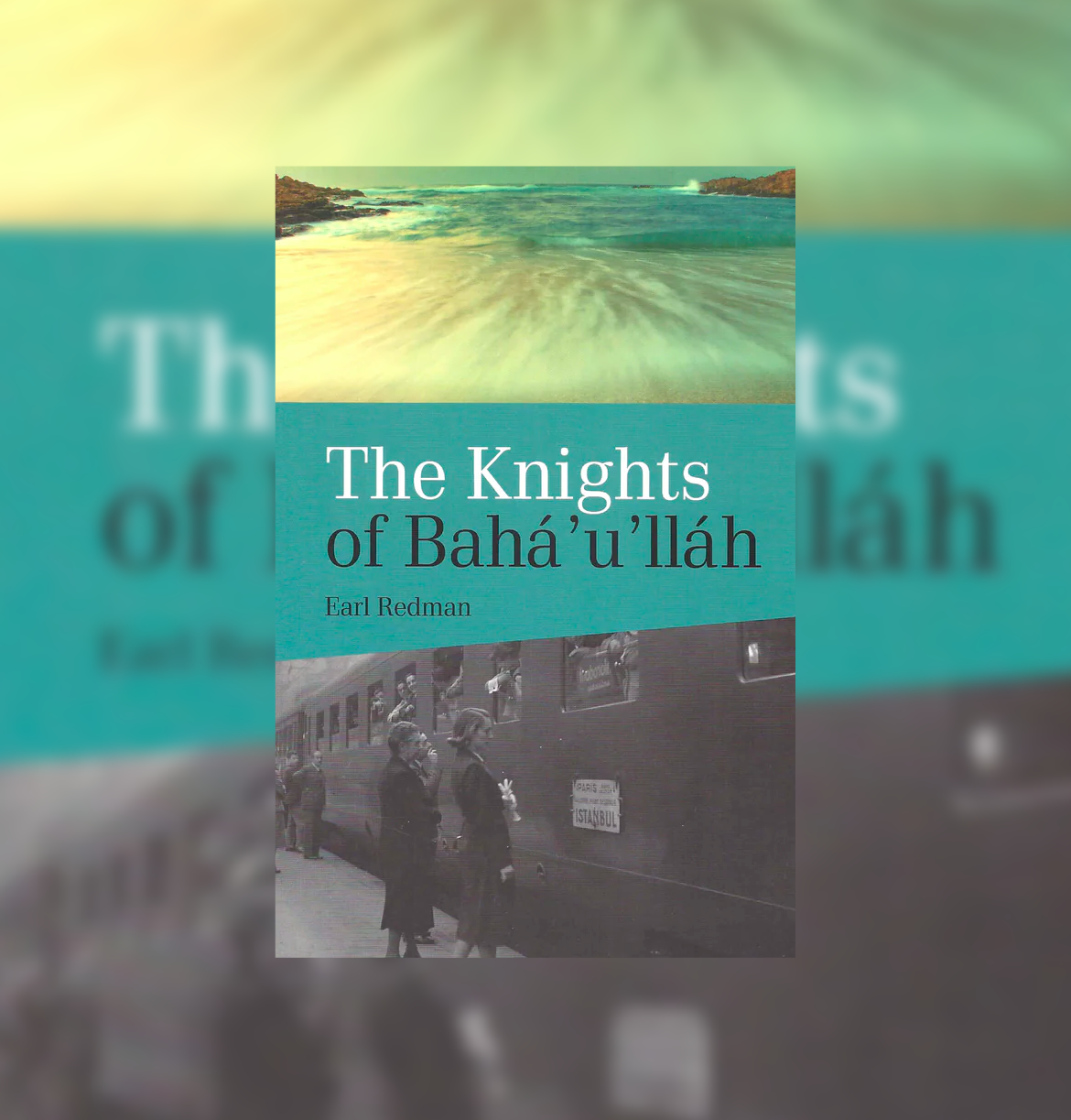
Knights of Baha'u'llah: The Stories of all the Knights of Baha'u'llah is Earl Redman’s sixth—monumental, extraordinary—book on Bahá'í history after his two volumes of pilgrims entering 'Abdu'l-Bahá’s presence—Visiting 'Abdu'l-Baha - Volume I: Volume I: The West Discovers the Master (1897-1911) and Volume II: The Final Years (1913–1921)—the book he wrote on 'Abdu'l-Bahá’s Journeys to the West— Abdu'l-Baha In Their Midst: The Master's Travel to the West —and his two books on the Guardian through the impressions of eastern and western pilgrims— Shoghi Effendi Through the Pilgrim's Eye Volume I: Building the Administrative Order (1922 - 1952), and Volume II: The Ten Year Crusade (1953 - 1963)
In his sixth book, Earl Redman does a deep dive into the stories of the lives and services of the 262 Knight of Bahá'u'lláh—257 during the Ten Year Crusade and 5 Knights of Bahá'u'lláh after its conclusion, who showed not a spirit of heroism and sacrifice, but indomitable spirit, courage and steadfastness in order to realize 'Abdu'l-Bahá’s greatest dream in the Tablets of the Divine Plan and implement the Guardian’s ardent wishes: they eventually won all of his pioneering goals for the Ten Year Crusade.
In the 512 pages of this book, a brigadier general in the Department of Defense go to an island so hot and so desolate that he cooks his eggs on beach rocks, a talented and promising young doctor gives up a promising, comfortable career to travel to a place where his outdoor latrine was above a snake-filled stream filled with water snakes.
These are not the stories you will read here. These stories reside in Earl Redman’s masterpiece on the Ten Year Crusade and its Knights of Bahá'u'lláh heroes. What you will find below is simply an homage to all the Knights of Bahá'u'lláh who arose and planted the flag of Bahá'u'lláh’s Faith over the entire earth. First, you will discover who the Knights of Bahá'u'lláh are, then, you will see the Roll of Honor, below that, there will be two lists with territories, names and a date: you can consider this the transcript of the Scroll of Honor.
To really plunge into the lives of the Knights of Bahá'u'lláh and learn their exciting adventurous stories—some of which are ten pages long—you must read Earl Redman’s book.
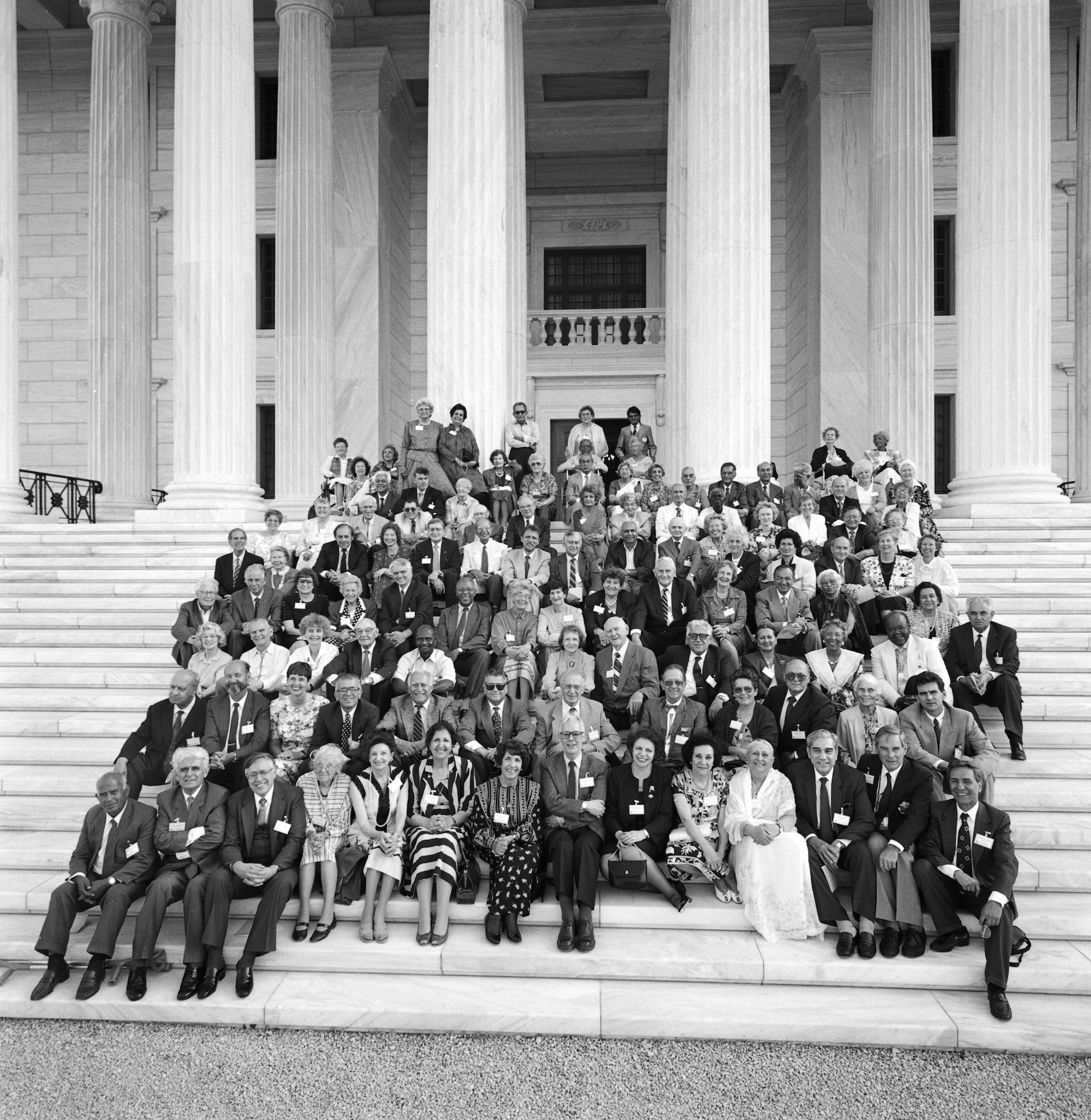
Knights of Bahá'u'lláh gather on the steps of the Seat of the Universal House of Justice, May 1992. Source: Bahá'í Media Bank, © Bahá'í International Community 2023.
When 'Abdu'l-Bahá was revealing the Tablets of the Divine Plan in Haifa, 'Akká, and Bahjí in the Springs of 1916 and 1917, and when the Tablets of the Divine Plan were unveiled to awestruck American Bahá'ís in April 1919, it was always the small band of lovers of Bahá'u'lláh who would have to accomplish His extraordinarily ambitious Divine Plan.
When the Guardian launched his first two national Seven Year Plans, when he inaugurated a handful of National Plans for National Spiritual Assemblies around the world, and when he launched the Ten Year Plan, it was that same small band of believers he was counting on.
At the time the Guardian launched the Ten Year Crusade, there were only 12 National Spiritual Assemblies and Bahá'ís lived in only 2,500 localities spread around 129 countries in the world.
Among these, a handful would rise up as heroes and win all of the Guardian’s pioneering goals, spreading the Faith to the remotest parts of the Congolese rainforest, and the most isolated islands in the Pacific Islands. This is their story.

Kneeling knight from the Westminster Psalter. A kneeling knight with his horse before setting off on the crusades. His servant leaning over the turret with his masters helmet Source: Wikimedia Commons.
Hand of the Cause Amatu’l-Bahá Ruḥíyyíh Khánum was “astonished,” in her words, when she realized the Guardian was using terms from the Middle Ages when speaking about the Ten Year Plan, and she immediately felt the weight of the symbolism:
(When) you received your knighthood, you had certain oaths of allegiance and service to take. It’s not a light term, knighthood. Shoghi Effendi attached tremendous importance to the Knights of Bahá’u’lláh.
First the Guardian called this ambitious plan the Ten Year Crusade. Second, he called its prosecutors Knights of Bahá'u'lláh. Knights fight in crusades. The terms come from a bloody period in history, but the sentiment of going where no one has gone before, heroism, sacrifice are all present in the terms as applied to the Ten Year Crusade. The Knights of Bahá'u'lláh were the spiritual soldiers of the Ten Year Crusade to spread the Bahá'í Faith to every corner of the earth. Spiritual Knights for a spiritual Crusade.
One day, Shoghi Effendi told Leroy Ioas, after expressing the urgent need to settle the 131 virgin territories immediately:
I have been thinking of what we should do to stimulate the Baha'is so that they will act quickly. I think we will call the people who settle in the coming year Knights of Bahá'u'lláh.
In Memorials of the Faithful, 'Abdu'l-Bahá had used a similar turn of phrase, which traditionally referred to the Promised Imam: “knight of the Lord of the Age,” something that prompted Rúḥíyyih Khánum to state that “all the fires the Guardian lit were from the sparks gathered so painstakingly from the writings of his forefathers.”
The first time the Guardian ever used the word “knights” in lowercase, was in a message dated 28 May 1953, speaking about making regular announcements regarding the “valiant knights” arriving at their pioneering posts.
The first time the Guardian ever used the phrase Knight of Bahá'u'lláh, was on 8 June 1953 in a letter addressed to India, regarding inscribing the names of the “Knight of Bahá'u'lláh” on a Roll of Honor. This quote is provided in full in the section on the Roll of Honor.
Amatu’l-Bahá Rúhíyyih Khánum, Shoghi Effendi’s wife and a Hand of the Cause, explained where the term ‘Knight’ of Bahá’u’lláh came from: Shoghi Effendi said that posterity would be proud of these souls who were the spiritual conquerors, his own term, of the entire globe.
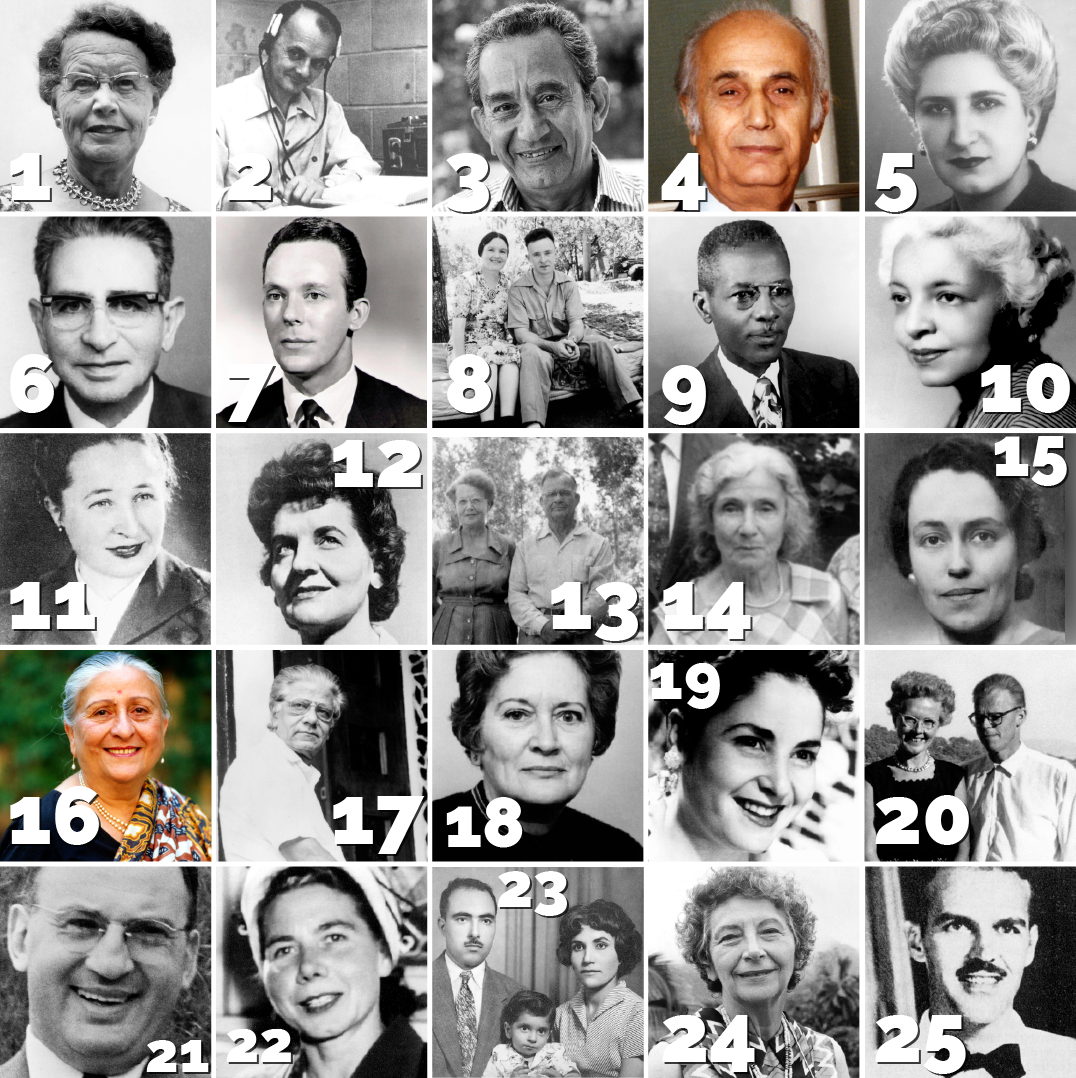
Some of the Knights of Bahá'u'lláh, men, women, couples and families, to show the variety of the heroes of the Ten Year Crusade: (1) Mary Collison (1892-1970), Knight of Bahá’u’lláh for Ruanda-Urundi; (2) Bruce Matthew, Knight of Bahá’u’lláh for Labrador, (3) Habib Isfahani, Knight of Bahá’u’lláh to Senegal, (4) Aziz Navidi, Knight of Bahá’u’lláh to Monaco, (5) Tahirih Ala’i, Knight of Bahá’u’lláh for Zimbabwe, (6) Eyneddin Ala’i, Knight of Bahá’u’lláh for Zimbabwe, (7) William Danjon, Knight of Bahá’u’lláh for Andorra, (8) Elizabeth and Frederick Laws, Knights of Bahá’u’lláh to Lesotho, (9) Julius Edwards, Knight of Bahá’u’lláh for Ghana, (10) Elsie Austin (1908-2004), Knight of Bahá’u’lláh for Morocco, (11) Ottilie Rhein (1903-1979), Knight of Bahá’u’lláh to Mauritius, (12) Florence Bagley (1914-1990), Knight of Bahá’u’lláh for Sicily, (13) Mary and Reginald (Rex) Collison, Knights of Bahá’u’lláh for Ruanda-Urundi, (14) Bertha Dobbins, Knight of Bahá’u’lláh for the New Hebrides Islands, (15) Dulcie Dive, Knight of Bahá’u’lláh for the Cook Islands, (16) Meherangiz Munsiff, Knight of Bahá’u’lláh to French Cameroon, (17) Abdu'l Rahman Zarqani, Knight of Bahá’u’lláh for the Seychelles Islands, (18) Edith Danielsen, Knight of Bahá’u’lláh for the Cook Islands, (19) lise Schreiber, Knight of Bahá’u’lláh for Spanish Guinea, (20) Jean and Tove Deleuran Knights of Bahá’u’lláh for the Balearic Islands, (21) Alvin Blum (1912-1968), Knight of Bahá’u’lláh for the Solomon Islands, (22) Violet Hoehnke (1916-2004), Knight of Bahá’u’lláh for the Admiralty Islands, (23) Knight of Bahá’u’lláh for Socotra Island, Mirza Aqa Khan Kamali Sarvistani with his wife, Rezwanieh and son, Alla’u’din, (24) Gertrude Blum (1910-1993), Knight of Bahá’u’lláh for the Solomon Islands, (25) Roy Fernie, Knight of Bahá’u’lláh for the Gilbert and Ellis Islands. All photographs of Knights of Bahá'u'lláh from Bahá'í Media Bank: Knights, © Bahá'í International Community 2023.
There would be 257 Knights of Bahá'u'lláh in total, 252 by 1963, and 5 additional Knights after the World Crusade had ended between November 1968 and March 1990, when the last five pioneering goals of the Ten Year Crusade were won.
The gender spread was astonishingly equal: there were 126 women and 131 men, 56 married couples—12 of them newly-married—69 single women and 66 single men.
The Knights of Bahá'u'lláh came from all backgrounds. Some came from families who had been brought into the Faith since the ministry of the Báb or Bahá'u'lláh, for several generations, and 24 Knights had been Bahá'ís less than 2 years.
The age gap was equally phenomenal: 13 Knights were teenagers and 11 were over 70. The youngest Knight of Bahá'u'lláh was Edward Tabe, a 14-year-old youth from Cameroon, the oldest was Nellie French, who was 85 years old when she pioneered to Monaco.
The Knights of Bahá'u'lláh were also on the spectrum of disability. For example, one Knight of Bahá'u'lláh, Catherine Huxtable, was in a wheelchair, and another, Jean Deleuran, had been partially disabled from polio when she was 16 years old.
The first Knight of Bahá'u'lláh to reach his pioneering post was Suhayl Samandarí, who arrived in Mogadishu, Somalia—then part of Italian Somaliland, on 19 March 1953.
The final Knights of Bahá'u'lláh were ‘Abbás and Rezvánieh Katirai, who pioneered to the last remaining goal of the Ten Year Crusade, Russia’s Sakhalin Island, 37 years after the Crusade, in March 1990.
There were two “Double Knights of Bahá'u'lláh” who opened two virgin territories each, a woman, Elilse Schreiber and a man Udaya Narayan Singh. Elise Schreiber opened St Thomas Island and Spanish Guinea in March 1954—these are now the countries of São Tomé and Príncipe and Equatorial Guinea. Udaya Narayan Singh was the Knight of Bahá'u'lláh for two territories as well: Sikkim, where he arrived in May 1955 and Tibet, which he reached in Mid-1956, crossing the border from Sikkim on foot at border at Yatung.
Three Knights of Bahá'u'lláh were future Hands of the Cause—they would be elevated to their rank on 2 October 1957—Raḥmatu'lláh Muhájir Knight of Bahá'u'lláh for the Mentawai Islands, Patrick Robarts, Knight of Bahá'u'lláh for Ashanti Protectorate (now part of Ghana) and Enoch Olinga, Knight of Bahá'u'lláh for the British Cameroon.
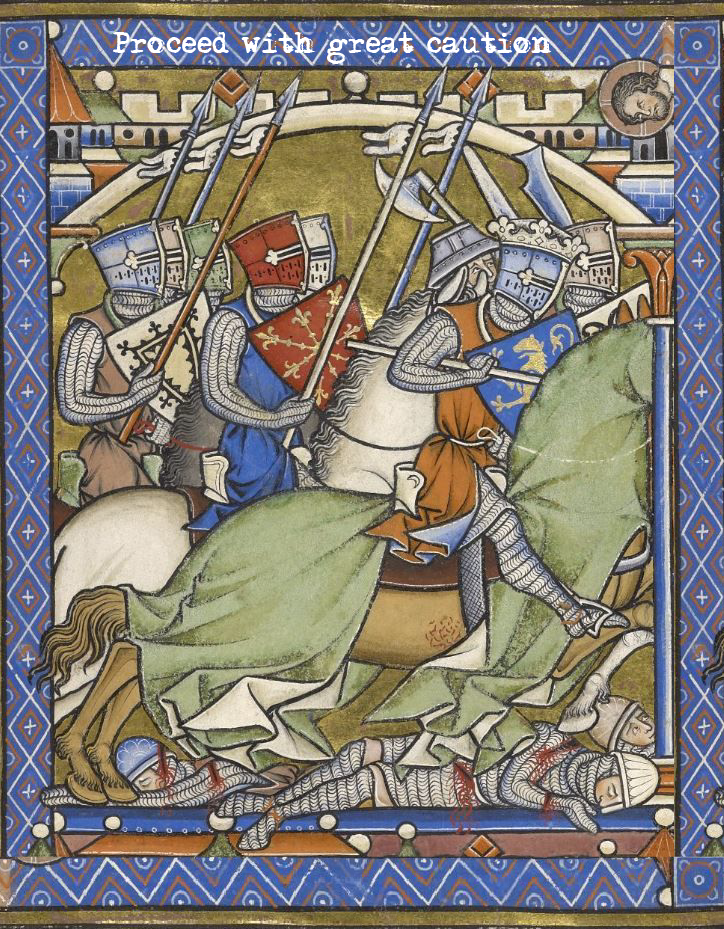
“Proceed with great caution.” Background image: ‘Israel Triumphant’: King David defeats the Philistines. From the Crusader Bible, The Morgan Library and Museum. Source: Wikimedia Commons.
On 7 December 1953, Leroy Ioas, as Secretary-General of the International Bahá’í Council in Haifa, sent their marching orders to the Knights of Bahá'u'lláh, in which he transmitted not only the general concept—that the Knights of Bahá'u'lláh were now the representatives of the Faith in their territory—but also including 9 numbered, very specific guidelines to adhere to regarding how they should behave, what they should do, and what they most definitely should avoid:
You are now the representative of the Faith in your area, and the beloved Guardian feels assured that you will arise to the great opportunity that has come to you, to become the one to quicken the souls in your virgin territory and become the spiritual conqueror of that new land.
The Guardian realises you will have many problems and difficulties, but he urges you to persevere under all circumstances, not to become disheartened in any way, but relying solely upon Bahá’u’lláh and His quickening Spirits, arise at once to carry forward the teaching work.
The Guardian makes the following suggestion with regard to teaching in virgin areas at this critical time:
1. No publicity should be secured
2. No articles should be placed in newspapers or magazines
3. Do not contact Authorities or Political Leaders
4. Do not discuss Government policies in any way
5. No effort should be made toward a public proclamation of the Faith
6. Proceed with great caution
7. Be very wise in the manner in which the Teachings of the Faith are presented.
8. Make friends, and when these friends gain confidence in you and you in them, gradually confirm them in the Faith.
9. What is needed is a complete reliance upon Bahá’u’lláh; pure consecration to the Faith, and then energetic but wise presentation of the Divine Teachings.
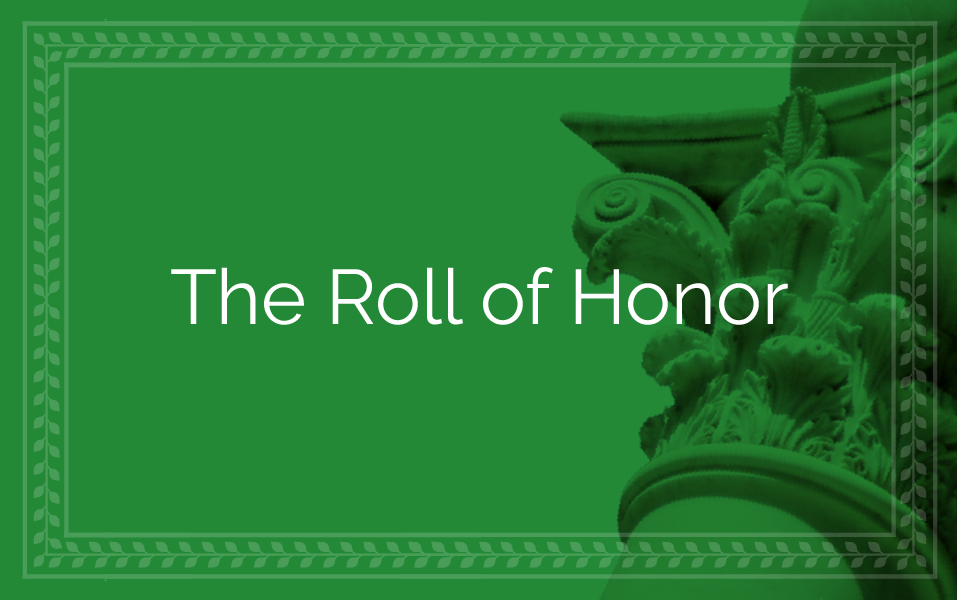

The Roll of Honor, listing all the Knights of Bahá'u'lláh of the Ten Year Crusade. At 27 Mb, this is the single largest image in the entire chronology. If you download the image or right-click on it to open it in another tab, the resolution is high enough for you to read the entries in each of the medallions. Source: Bahá'í Library Online, originally published in The Bahá'í World, Voume. 20 (1986-1992).
In a cable on 28 May 1953, the Guardian sent the first cable in which he mentioned his plan to inscribe the names of the Knights of Bahá'u'lláh on a Roll of Honor:
Planning to inscribe, in chronological order, the names of the spiritual conquerors on an illuminated Roll of Honor, to be deposited at the entrance door of the inner Sanctuary of the Tomb of Bahá'u'lláh, as a permanent memorial of the contribution by the champions of His Faith at the victorious conclusion of the opening campaign of the Global Crusade which is destined to attain consummation at the Most Great Jubilee commemorating the Centenary of the Declaration of His Mission.
Only those Bahá'ís arising in the first year of the Ten Year Crusade could be considered Knights of Bahá'u'lláh and have their names inscribed on this Roll of Honor for all time. Nothing mattered except that they arose and arrived. The only exception were Knights settling in virgin territories, throughout the Ten Year Crusade after 1954. Their names were also inscribed. It was not a requirement to stay a specific length of time. One Knight of Bahá'u'lláh never left the airport. Success in teaching did not matter, all that mattered was that they opened a new territory .
On 20 September 1953, just a few weeks before the fourth Intercontinental Teaching Conference in Asia, Shoghi Effendi sent a cable entitled “Roll of Honor,” which fully displayed the Guardian’s sense of pomp and circumstance. He announced to the Bahá'í world that just after four months after the first Intercontinental Teaching Conference in Africa, already 28 virgin territories had been opened to the Faith by more than 300 dedicated pioneers, and shared the first 28 names inscribed on the Roll of Honor, which he would soon begin referring to as Knights of Bahá'u'lláh.
The scroll you see below is the exact scroll designed by Shoghi Effendi. It is 45.5 centimeters wide by 84 long, and the names of the Knights of Bahá'u'lláh were inscribed, each within its own a medallion embossed in gold and decorated with floral designs, bearing the name of the territory.
Thereafter, whenever Knights of Baha'u'llah came to Haifa on pilgrimage Shoghi Effendi brought out the scroll with their names on it.
On 28 May 1992, during the commemoration of the Centenary of the Ascension of Bahá’u’lláh, and two years after the last territory had been conquered—The Islands of Sakhalin—the Roll of Honor was finally placed below the threshold at the entrance door to the Shrine of Bahá'u'lláh, by Hand of the Cause Amatu’l-Bahá Ruḥíyyíh Khánum, the widow of the Guardian.

Examples of territories that listed at least three Knights of Bahá'u'lláh at different dates, from left to right, top to bottom row: Southern Rhodesia, Spanish Morocco, Moroccan Zone, Monaco, Brunei, French Togoland, Diu Island, Leeward Islands, Bahamas Islands. Frame asset from Freepik.
When you look at the Roll of Honor, you see many territories with a single name in the flourished oval, and you immediately notice several with two, three, five names or more. The Morocco International Zone, the most extreme example, has 13 names listed on the Roll of Honor, all of whom arrived between 30 September 1953 and 12 April 1954. All 13 were Knights of Bahá’u’lláh.
Why is that?
Earl Redman explains this beautifully in his book on the Knights of Bahá'u'lláh. The Guardian opened the Roll of Honor for the Knights of Bahá'u'lláh for the first year of the plan. Between 1953 and 1954, any Bahá'í entering any virgin territory—regardless of whether a Bahá'í had already settled it—automatically became a Knight of Bahá'u'lláh.
On 4 May 1954, the Guardian officially closed the Roll of Honor. What this meant was that anyone who pioneered to the country while the Roll of Honor was still open would be considered a Knight of Bahá'u'lláh. If a person arrived just one day after, on 5 May 1954, they would not be named a Knight of Bahá'u'lláh.
Anyone who settled into one of the goal territories of the Ten Year Crusade after Riḍván 1953 and before Riḍván 1954 was named a Knight of Bahá'u'lláh.


By the end of the Ten Year Crusade in 1963, the Knights of Bahá'u'lláh had opened all the remaining virgin areas to the Faith with the exception of the five territories indicated in white on this map. Map asset from Freepik.
This is the list of the territories they opened, their names and the date they fulfilled the goals of 'Abdu'l-Bahá and Shoghi Effendi. Their full stories can be found in The Knights of Bahá'u'lláh by Earl Redman.
NORTH AFRICA
- French Somaliland (now Djibouti): Fred Schechter and Fahíma and Sabrí Elias (August 1953 to May 1954)
- French West Africa (includes parts of what are now Burkina Faso, Côte d’Ivoire, Mali, Mauritania, Niger, Senegal): Labíb and Ḥabíb Iṣfahání (November 1953 to April 1954)
- Hadhramaut (now part of Yemen): Adíb and Vahídih Baghdádí, and Ḥusayn Halabi (December 1953 to February 1954)
- Italian Somaliland (now part of Somalia): Suhayl, Mihdí and Ursula Samandari (March to November 1953)
- Morocco, International Zone: Manúchihr Hizárí, Hurmuz Zindih, Elsie Austin Muḥammad ‘Alí Jalálí, Ḥusayn and Nusrat Ardikání 'Alí Akbar Rafí'í and Sháyistih and ‘Abbás Rafí'í Rafsanjání, Evelyn and Richard Walters, and Mary and Richard Suhm (September 1953 to April 1954)
- Portuguese Guinea (now Guinea-Bissau): José Xavier Rodrigues and Hilda Summers (September 1953)
- Rio de Oro (now Spanish Sahara): ‘Amín Battáh and Muḥammad Muṣṭafá Sulaymán (October 1953)
- Spanish Morocco: Bahía and Fawzí Zaynu'l-‘Ábidín—this author’s grandparents—Luella McKay, Erleta and John Fleming and Alyce Barbara May Janssen (October 1953)
- The Gambia: Faríburz Rúzbihíyán (February 1954)
SOUTHERN AFRICA
- Ashanti Protectorate (now part of Ghana): Benedict Eballa (April 1954)
- Bechuanaland (now Botswana): John, Audrey, and Patrick Robarts (February 1954)
- British Togoland (now part of Ghana): Edward Tabe and Albert Buapiah (April 1954)
- French Cameroon (now part of Cameroon): Samuel Njiki Njenji and Meherangiz Munsiff (April 1954)
- French Togoland (now Togo): David Tanyi and Vivian Wesson and Mavis Nymon (April 1954 to May 1954)
- Northwest Territories Protectorate (now part of Ghana): Julius Edwards and Martin Manga (September 1953 to April 1954)
- Ruanda-Urundi (now Rwanda and Burundi): Mary and Rex Collison: Dunduzu Kaluli Chisiza (May 1953)
- South West Africa (now Namibia): Edward Cardell (October 1953)
- Southern Rhodesia (now Zimbabwe): Ezzatu’llah Zahra’i, Claire Gung ‘Aynu’d-Dín ‘and Ṭáhirih ‘Alá’í, Roberta and Kenneth Christian (June 1953 to January 1954)
- St Thomas Island (now The Democratic Republic of São Tomé and Príncipe) and Spanish Guinea (now Equatorial Guinea): Elise Schreiber (February 1954)
- French Equatorial Africa (now Congo): Max Kanyerezi (October 1953)
- Swaziland: Bula Mott Stewart, John, and Valera Allen (April 1954)
- Basutoland (now Lesotho): Elizabeth and Frederick Laws (October 1953)
- British Cameroon (now part of Cameroon): Enoch Olinga (October 1953)
INDIAN OCEAN
- Andaman Islands: Khodadad M. Fozdar (November 1953)
- Chagos Islands: Pouva Murday (May 1957)
- Cocos Islands: Frank Wyss (June 1955)
- Comoros Islands: Mehrabán Sohailí (August 1954)
- Kuria Muria (Oman): Munír Vakíl (January 1954)
- Mauritius: Ottilie Rhein (November 1953)
- Nicobar Islands: Jeanne Frankel and Margaret Bates (July 1957)
- Reunion Island: Opal and Leland Jensen (October 1953 to March 1954)
- Seychelles Island: Kámíl ‘Abbás and ‘Abdu’l Rahman Zarqani (November 1953 to January 1954)
- Socotra Islands: Kamálí Sarvistání (March 1955)
INDIA AND THE HIMALAYAS
- Bhutan: Shápúr Rawhání and Ardishír Furúdí (June 1954)
- Daman: Ghulám-‘Alí Karlawala (June 1953)
- Diu Island: Gulnar Aftábí, Kaykhusraw Dahamobedi and Bahíyyih Rawhání (December 1953)
- Goa: Rawshan Áftábí and Fírúzih Yigánigí (July 1953)
- Karikal: Shírín Núrání and Salisa Kirmání (August 1953)
- Mahé: Lionel Peraji, Qudratullah Rowhani and Khodarahm Mojgani (October 1953 to March 1954)
- Pondicherry: Sa’íd and Shawkat Nahví: Shyam Beharilal Bhargava (July to November 1953)
- Sikkim and Tibet: Udaya Narayan Singh (May 1955 and Mid-1956)
CHINA, INDONESIA AND MALAYSIA
- Brunei: Charles Duncan and Harry Clark and John Fozdar (February to April 1954)
- Dutch New Guinea (now part of Indonesia): Elly Becking and Lex
- Hainan Island: John Chang (August 1959)
- Macao: Frances Heller and Carl and Loretta Scherer (October 1953
- December 1953)
- Meerburg Mentawai Islands (part of Indonesia): Raḥmatu'lláh and Írán Muhájir (February 1954)
- Portuguese Timor (now East Timor): Harold and Florence Fitzner and José Marques (Moucho) (June to July 1954)
THE PACIFIC ISLANDS
- Admiralty Islands: Violet Hoehnke (July 1954)
- Caroline Islands: Virginia Breaks (January 1954)
- Chiloé Island, Chile: Zunilda Gonzales Jara de Palacios and Louise Groger (October 1953 toJune 1954)
- Cook Islands: Edith Danielsen: Dulcie Dive (October 1953 to January 1954)
- Galapagos Islands: Gayle Woolson and Haik Kevorkian (April to May 1954)
- Gilbert and Ellice Islands (now Kiribati): Roy and Elena Fernie (March 1954)
- Juan Fernandez Islands, Chile: Adela and Salvador Tormo (October 1953)
- Loyalty Islands: Daniel Haumont (October 1954)
- Mariana Islands: Robert Powers and Cynthia Olson (April to May 1954)
- Marquesas Islands: Gretta Jankko (March 1954)
- Marshall Islands: Marcia Stewart (August 1954)
- New Hebrides Islands: Bertha Dobbins (October 1953)
- Samoa: Lilian Wyss (January 1954)
- Society Islands: Gretta Stevens Lamprill and Gladys Parke (October 1953 )
- Solomon Islands: Gertrude and Alvin Blum (March 1954)
- Tonga: Stanley Bolton and Dudley and Elsa Blakely (January to July 1954)
- Tuamotu Archipelago: Jean Sevin (January 1954)
ALASKA AND CANADA
- Aleutian Islands: Jenabe and Elaine Caldwell: Elinore Putney (July 1953 to May 1954)
- Anticosti Island, Quebec: Mary Zabolotny (April 1956)
- Baranof Island: Helen Robinson: Grace Bahovec: Gail Avery (October 1953 to February 1954)
- Cape Breton Island, Nova Scotia: Irving and Grace Geary and Frederick and Jeanne Allen (October 1953)
- Franklin: Jameson and Gale Bond (July 1953)
- Grand Manan Island, New Brunswick: Doris Richardson (September 1953)
- Gulf Islands, British Columbia: Catherine and Clifford Huxtable (September 1959)
- Keewatin: Dick Stanton (September 1953)
- Kodiak Island: Jack Huffman and Rose Perkal: Ben Guhrke (July 1953 to February 1954)
- Labrador: Howard Gilliland and Bruce Matthew (April 1954)
- Magdalen Islands, New Brunswick: Kathleen Weston and Kay Zinky (September 1953 to April 1954)
- Queen Charlotte Islands, British Columbia: Edythe MacArthur (August)
- St Pierre and Miquelon Islands (near Newfoundland): Ola Pawlowska (October 1953)
- Yukon: Joan and Ted Anderson (September 1953)
THE CARIBBEAN, AND CENTRAL AND SOUTH AMERICA
- British Guiana (now Guyana): Malcolm King (October 1953)
- British Honduras (now Belize): Shirley Warde and Cora Oliver (September 1953)
- Dutch Guiana (now Suriname): Elinor and Robert Wolff (October 1953)
- Dutch West Indies: Matthew Bullock: John and Marjorie Kellberg
- French Guiana: Eberhart Friedland (October 1953)
- Key West, Florida: Arthur and Ethel Crane: Howard Snider (July to September 1953)
- Leeward Islands: Earle Render, Ben and Gladys Weeden, David Schreiber and Charles and Mary Dayton (October 1953 to February 1954)
- Margarita Island: Katharine Meyer (October 1953)
- The Bahamas: Ethel and Maurice Holmes, Gail and Gerald Curwin and Andrew and Nina Matthisen (October 1953)
- Windward Islands: Esther Evans and Lillian Middlemast (October 1953)
EUROPE
- Andorra: William Danjon (October 1953)
- Balearic Islands: Virginia Orbison Tove, Jean Deleuran and Charles Ioas (August to December 1953)
- Channel Islands: Evelyn Baxter and Ḍíyá’u’lláh Aṣgharzádih (September 1953)
- Crete: Rolf Haug (October 1953)
- Cyprus: Abbas and Semire Vekil: Hugh and Violet McKinley (August to November 1953)
- Faroe Islands: Eskil Ljungberg (July 1953)
- Frisian Islands: Elsa Maria Grossmann, Ursula von Brunn and Geertrui Ankersmit (September to October 1953)
- Greece: Sheila and Amin Banani: Dwight and Carole Allen (August 1953 to
- September 1953)
- The Hebrides Islands: Geraldine Craney (October 1953)
- Liechtenstein: Amír Húshmand Manúchehrí (August 1953)
- Lofoten Islands: Loyce Lawrence and Mildred Clark (August 1953)
- Malta: Una Townshend, Olga Mills and John Mitchell (October 1953 to July 1954)
- Monaco: Nellie French, Shamsí and ‘Azízu’lláh Navídí, Olivia Kelsey and Florence Ullrich (September 1953 to March 1954)
- Orkney Islands: Charles Dunning (October 1953)
- Rhodes: Elizabeth Bevan (January 1954)
- San Marino: Tábandih and Suhráb Paymán (November 1953 to April 1954)
- Sardinia: Marie Ciocca (October 1953)
- Shetland Islands: Brigitte Hasselblatt (September 1953)
- Sicily: Emma Rice, Florence, Stanley, Gerrold, Carol and Susan Bagley (October 1953)
- Spitsbergen: Paul Adams (27 June 1958)
THE ATLANTIC OCEAN
- Azores: Richard and Lois Nolen (October 1953)
- Canary Islands: George and Marguerite (Peggy) True: Gertrude Eisenberg: Shoghi-Riaz Rouhani (October 1953 to April 1954)
- Cape Verde Islands: JoAnne and Howard Menking (January 1954)
- Falkland Islands: John Leonard (February 1954)
- Madeira: Elizabeth Hopper, Ada Schott, Ella Duffield and Sara Kenny (September 1953)
- Helena Island: Elizabeth Stamp (May 1954)
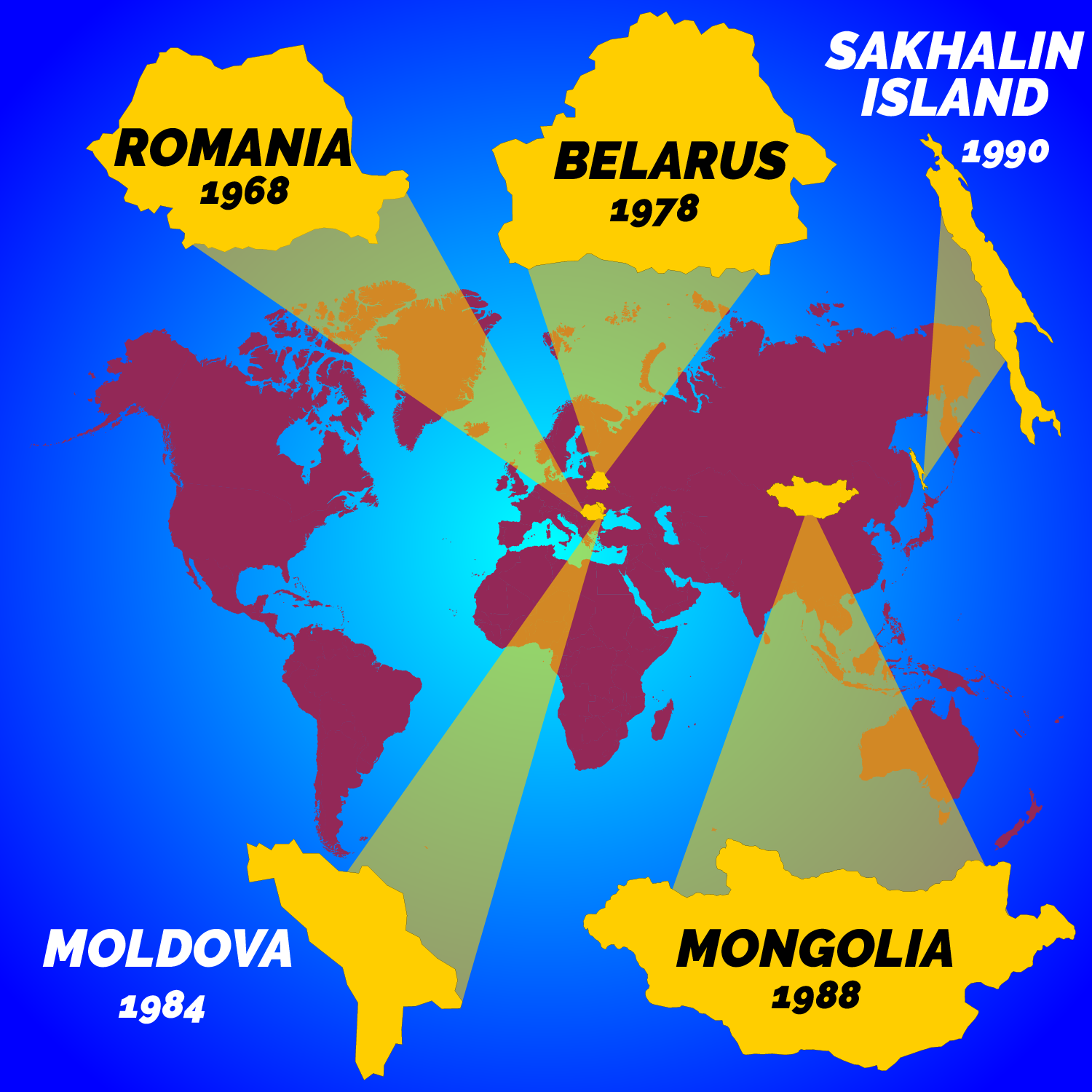
Between 1968 and 1990, the five remaining territories, Romania, Belarus, Moldova, Mongolia and Sakhalin Island, had been opened. The entire world had now been opened to the Faith. Map asset from Freepik.
At the end of the Ten Year Crusade, there were only 5 territories left on the surface of the planet to open to the Bahá'í Faith. Although these territories were settled by Knights of Bahá'u'lláh after the cut-off date of Riḍván 1963, they are still considered Knights of Bahá'u'lláh by virtue of the fact they were the first Bahá'ís to set foot into their respective territories. All five individuals’ names were inscribed on the Roll of Honor. These are the five countries and regions settled between 1968 and 1990:
- Romania: Fereydoun Khazrá’í (November 1968)
- Belarus: Helmut Winkelbach (1978)
- Moldova: Annemarie Krüger-Brauns (1984)
- Mongolia: Sean Hinton (1988)
- Sakhalin Island, Russia: Abbás and Rezvánieh Katirai (March 1990)
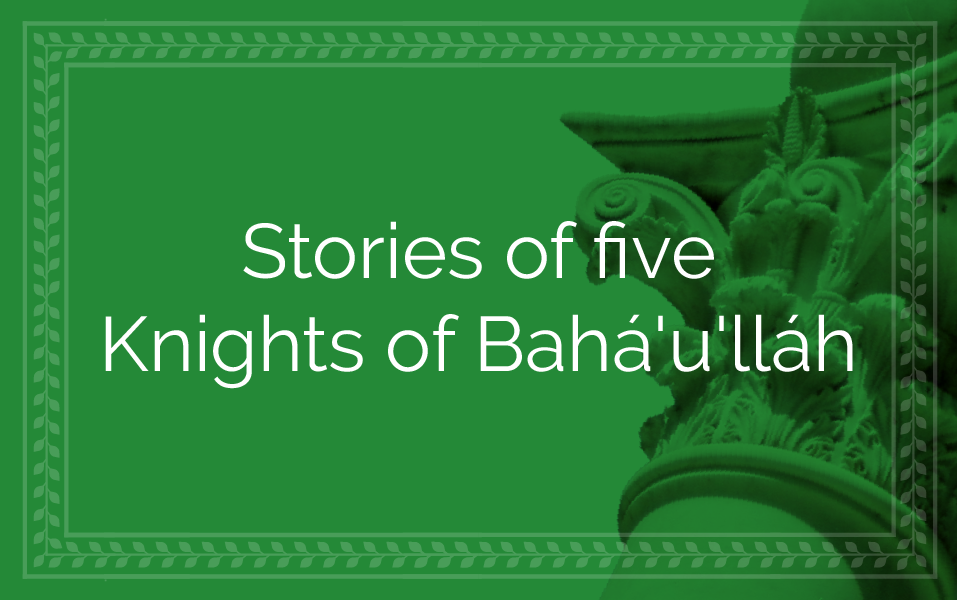
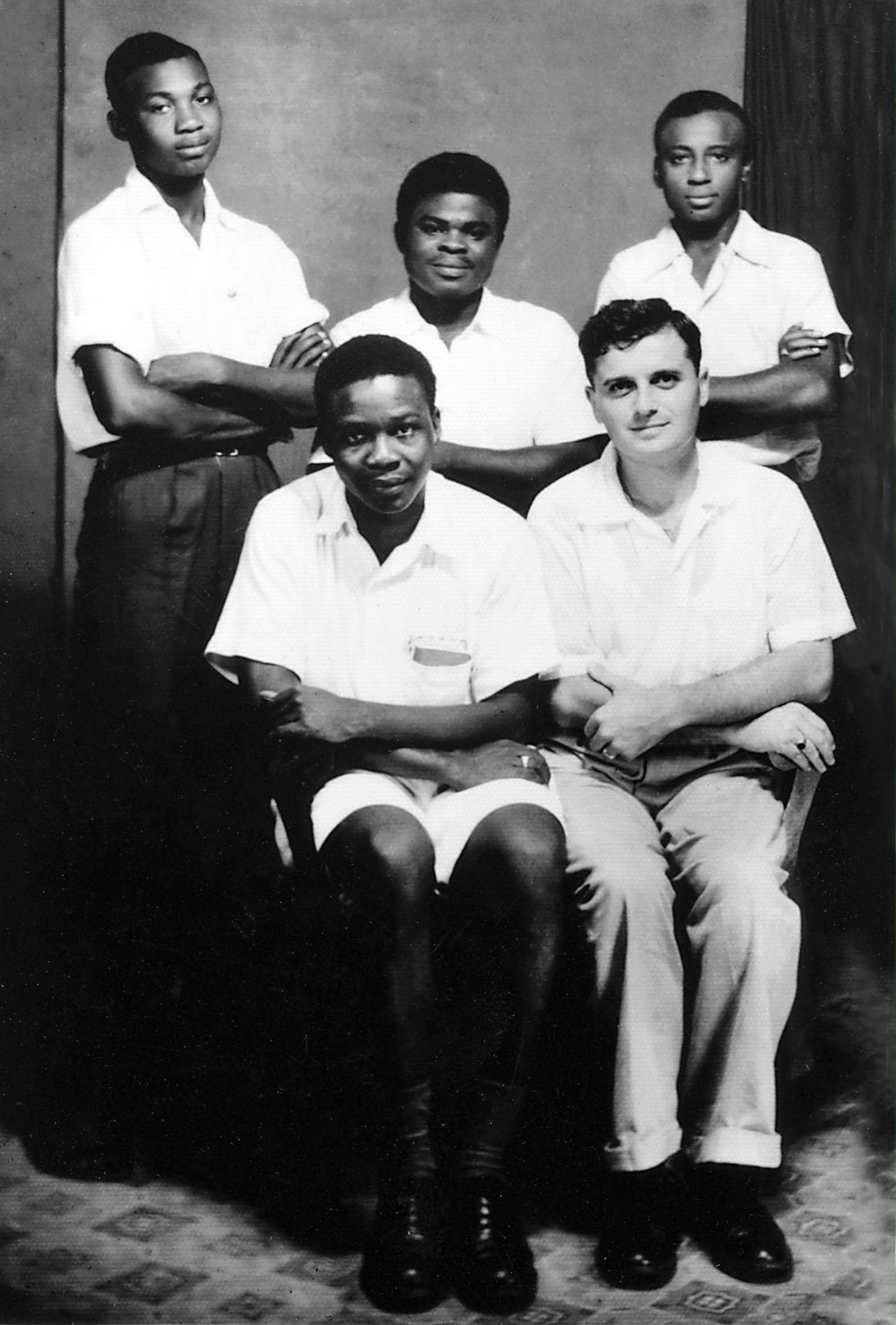
Sitting left to right: Enoch Olinga—Knight of Bahá'u'lláh for the British Cameroons—and ‘Alí Nakhjávání. Standing left to right: Three Knights of Bahá'u'lláh, Samuel Najiki, David Tanyi, and Benedict Ebala. Source: Bahá'í World News Service.
When Enoch Olinga—who was at the time living in East Africa, in Kampala, Uganda—raised his hand and volunteered to pioneer to British Cameroon, ‘Alí Nakhjávání asked him why, and Enoch Olinga responded:
Because it’s the farthest goal from here.
Soon after becoming a Bahá'í in Kampala, Enoch Olinga, together with fellow new believers Max Kanyerezi and Samson Mungono, responded to the Guardian’s call and left their home in Uganda, to fulfill pioneering goals.
Some time in the late spring or early summer of 1953, ‘Alí and Violette Nakhjávání drove their Peugeot station wagon for three months from Uganda to Central Africa, covering an astonishing 5,000 kilometers to drop off their three dear Ugandan Bahá'ís at their pioneering posts.
The first leg of their journey was to Kamina in the Katanga region of the Belgian Congo—now the Democratic Republic of Congo—approximately 1,200 kilometers southwest of Kampala, Uganda. In Kamina, they dropped off Samson Mungono. The Belgian Congo was not a goal of the Ten Year Crusade—and so Samson Mungono was not a Knight of Bahá'u'lláh.
The Guardian and Rúḥíyyih Khánum were the very first Bahá'ís to set foot in the Belgian Congo, and so it is exact to say that the Guardian opened the Belgian Congo to the Faith over the course of several weeks in 1940, 13 years before the Ten Year Crusade.
For the second leg of the journey, ‘Alí and Violette Nakhjávání drove 1,300 kilometers northwest to Brazzaville to drop off Max Kanyerezi. Max Kanyerezi became a Knight of Bahá'u'lláh when he set foot in Brazzaville, in the Republic of Congo in September 1953
The third leg of the journey was the hardest. They took a grueling route through the thick rainforests of the Republic of Congo and Gabon, still travelling northwest towards Cameroon. Their Peugeot broke down in the forest, and they were unable to continue by car. Enoch Olinga, a city man not accustomed to jungles and scared of snakes, walked 56 miles through the thick forest to get help, battered by heavy tropical rain, and avoiding elephants.
By this point, Enoch was exhausted, covered in mud, worried about ‘Alí and Violette Nakhjávání all alone in the forest in their broken-down car, and he stopped and cried out:
Why have I come here? I have left my family in Uganda. I’ve come here in the jungles of Cameroon and different countries. Why am I here?
Enoch Olinga fell asleep and dreamt that the Guardian held his hand, pulled him out of the mud, and sat next to him saying:
I am so pleased with you.
Enoch Olinga woke up a different man. He continued walking to get help, but ‘Alí and Violette Nakhjávání caught up to him, having managed to repair the car since he left. When they found him, Enoch Olinga was so ill, he was hospitalized for two days and was unable to travel for a week. By mid-October, they were back on the road and Enoch Olinga was the first Bahá'í to set foot in British Cameroon, becoming a Knight of Bahá'u'lláh when he arrived in Limbé.
Having accomplished this superhuman feat, ‘Alí and Violette Nakhjávání now had to drive back 2,500 kilometers due east From Cameroon to Kampala.
Samson Mungono, Max Kanyerezi, and Enoch Olinga all brought massive numbers of Bahá'ís into the Faith, as did ‘Alí Nakhjávání in Uganda.

Left photograph: Enoch Olinga, Knight of Bahá'u'lláh for the British Cameroons. Source: Bahá'í Media Bank, © Bahá'í International Community 2023. Right photograph: three of Enoch Olinga’s five spiritual children who went on to become Knights of Bahá'u'lláh: Knights of Bahá’u’lláh for French Togoland, David Tanyi (standing) and Benedict Eballa (left), with Samuel Njiki, Knight of Bahá’u’lláh for French Cameroon, 1954. Source: Bahá'í Media Bank, © Bahá'í International Community 2023.
From his arrival in Limbé, Cameroon on 15 October 1953 to April 1954, Enoch Olinga brought nine strong believers into the Faith. At the beginning of April 1954, less than a year after Enoch Olinga had arrived in Cameroon, the Guardian sent an urgent message about the African goals of the Ten Year Crusade:
Urgent entry African believer virgin territories British French Togolands Ashanti Protectorate northern Territories Protectorate before Ridván will ensure victory. Shoghi[
By this point, in just six months, Enoch Olinga had taught a group of very staunch, deeply Bahá'ís the youngest one, 14 years old. This historic group of Bahá'ís included Samuel Njiki, Edward Tabe, Albert Buapiah, Martin Manga, Ben Eballa and 4 others. When they read this message from the Guardian, all 9 wanted to go, but there was only a need for five pioneers, so they had an election. These were the results of the election, accompanied by the date at which each Knight of Bahá'u'lláh arrived at his post:
- Samuel Njiki pioneered to French Cameroon (now part of Cameroon) on 9 April 1954
- David Tanyi arrived in French Togoland (the present Togo) on 13 April 1954
- Edward Tabe—the youngest Knight of Bahá'u'lláh at 14 years old—moved to British Togoland (now a part of Ghana) on 13 April 1954
- Benedict Eballa set foot in the Ashanti Protectorate (now called Ghana), and on 16 April 1954
- Martin Manga settled in northern Territories Protectorate on 16 April 1954
This was Bahá'í history, and it was, once again, something happening in Africa which brought immense joy to the burdened heart to the Guardian: from a single country, five Knights of Bahá'u'lláh, all Bahá'ís less than six months, and all taught by the same person, Enoch Olinga, a future Hand of the Cause, had arisen from the same city to win victories for the Guardian at the moment he needed it most.
By Riḍván 1954, at the same time as the five Knights of Bahá'u'lláh had left for their pioneering post, Enoch Olinga had managed to raise up the Local Spiritual Assembly of Limbé, in British Cameroon.
For this incredible feat, the Guardian gave Enoch Olinga an Arabic title: ‘Abu’l-Futuh—the Father of Victories. This story is told in full in the next part of the chronology.
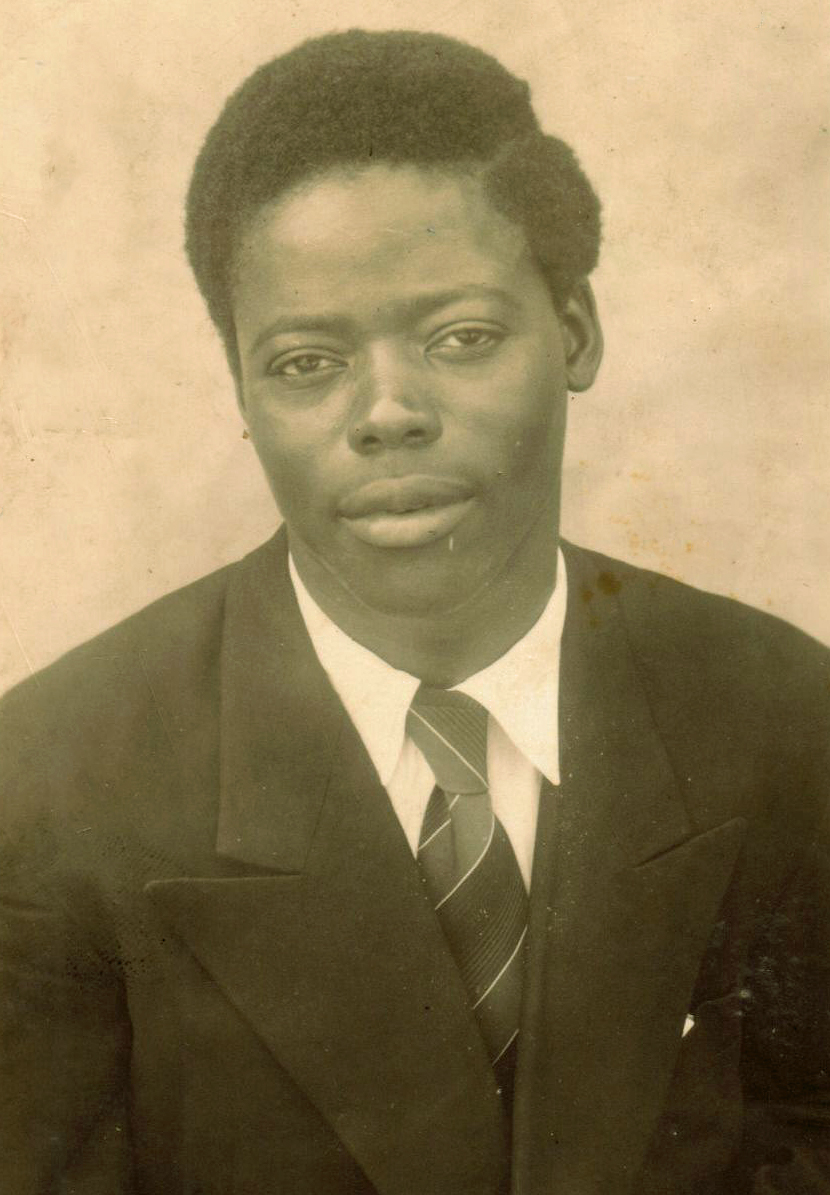
Portrait of Edward Tabe from The Knights of Bahá'u'lláh, by Earl Redman, George Ronald, 2017, Kindle Edition. © George Ronald, used with permission.
Edward Tabe was born in 1940 and is still alive today. Edward Tabe was introduced to the Faith when he was around 13 years old and working as a messenger at a Limbé hospital. He belonged to the same tribe as David Tanyi and Enoch Olinga taught both of the Faith in late 1953.
Edward Tabe became a Bahá'í in April 1954, and a week later, he volunteered to pioneer to a goal area. When they drew lots to choose the five future Knights of Bahá'u'lláh, Edward Tabe drew British Togoland, a colony which later became a part of Ghana.
Enoch Olinga and ‘Alí Nakhjávání and the five Cameroonian Knights of Bahá'u'lláh— Samuel Njiki, David Tanyi, Benedict Eballa, Martin Manga, and Edward Tabe—flew to Lagos, Nigeria, then traveled by truck to Lomé, Togo.
Edward Tabe continued on to Ho, in British Togoland, where he arrived on 14 April 1954.
He had just become the youngest Knight of Bahá'u'lláh in history, just 14 years old.
Edward Tabe quickly found a job in the Education Office, and lived near David Tanyi, who was in Lomé, so they saw each other frequently. By Riḍván 1955, the Local Spiritual Assembly of Ho was raised thanks to Edward Tabe’s efforts and he served on the West Africa Teaching Committee from 1957 to 1959 he served on the West Africa Teaching Committee and assisted in opening up new territories to the Faith, before leaving Ghana in 1960.

Frank Wyss was born in Sydney, Australia, on 21 December 1927 of Swiss parents. While attending Bowral High School, Frank discovered the Bahá'í Faith through his classmates, Stanley Jr., Antoinette, and Mariette Bolton. He and his sister, Lilian, declared in 1944 while attending the Annual Bahá'í Summer School in Yerrinbool.
Frank and Antoinette Bolton moved to the United States to study chiropractic medicine and returned to Australia in May 1948, where he began practicing as a traveling chiropractor for Stanley and Mariette Bolton in a Bedford utility truck.
Frank Wyss was elected on to the National Spiritual Assembly of Australia in 1954 but resigned his position to rise up and pioneer to the Cocos Islands, a territory consisting of two atolls 2 meters in elevation at its highest point and consisting of 27 coral islands, of which only two are inhabited—West Island and Home Island.
Frank chose the Cocos Islands because, as an Australian, he didn’t need permission or a visa to travel there, and so he arrived at Cocos Islands Airport on West Island on 4 June 1955. The only two things Frank new about the Cocos Islands was that they were a refueling stop on the plane route between Australia and South Africa and that it did not have hotels, so he brought a tent and food, and was prepared to camp.
At the time, Cocos Islands had a self-appointed “King” and resident magistrate, named John Cecil Clunies-Ross, who would not allow Frank to set foot on the island, and put him on the next flight back to Australia, which left 18 days later, on 22 June 1955. Frank Wyss spent 18 days in the Cocos Islands airport
Frank tried to return, but it wasn’t possible.
Frank Wyss would be the only Knight of Bahá'u'lláh who never set foot onto his territory.
He was a man of profound integrity and becoming a Knight of Bahá'u'lláh in the circumstances he had made him very uncomfortable. He even said he wasn’t happy being named a Knight of Bahá’u’lláh because he couldn’t stay at his post.
In 1955 when Frank Wyss went on pilgrimage and met the Guardian, he reiterated his concern, and Shoghi Effendi told him that he had gone to his post, and he would have stayed if he could.
Becoming a Knight of Bahá'u'lláh was not just about the result, it was mostly about the pure intent.

Back row, standing left to right: Mr. Masrour, Fawzi Zaynu'l-‘Ábidín, Richard Walters, a Knight for Morocco International Zone—Abdu’lláh Mesbah, Fu’ad Aḥmadpour. Front row: Cherif, Bahia and Kamal, the wife and children of Fawzi Zaynu'l-‘Ábidín. Kamal Zein is this author’s father. Caption details provided by Mohammed Otmani Kebdani. Source: Zein family archives.
Bahia Saad el Dine was born on 18 November 1926, on the fifth floor of an apartment building in Port Said, Egypt. Where Bahia grew up, there were horses, goats, chickens, mulberry trees. Her mother, ‘Ismat ‘Ali Effendi, was the daughter of the first Egyptian Bahá'í, Ibrahim Effendi ‘Alí, and her father was a Lebanese landowner. 'Abdu'l-Bahá Himself had arranged their marriage.
Bahia’s father, ‘Alí Saad el Dine, who grew oranges up and down the coast of Palestine between Jaffa and Haifa, shipping them out in wooden crates, individually wrapped in silk-paper. His lands were donated to the Faith and ‘Alí Nakhjávání once pointed out to me the very edge of the northwestern corner of the Seat of the Universal House of Justice, saying:
That small corner of the Seat was built on your great-grandfather’s land.
When Bahia was a very young child, she was so high-spirited and outspoken that her family gasped in horror when Bahia sat on the lap of the Greatest Holy Leaf, who was visiting Egypt. “What will Bahia say to her?” they thought with anxiety. When Bahia returned, they asked her what she had said, and the little girl replied:
I told her she has nice hands.
The Greatest Holy Leaf gave Bahia a ring which she kept for her entire life.
Fawzi’s father was named Zaynu’l-‘Abidin Isma’il. He was Persian, originally from Hamadán, and had left his country immediately after declaring when he was 18 years old, settling in Cairo.
Fawzí Zaynu'l-‘Ábidín was born in Cairo on 28 January 1911. When his father asked 'Abdu'l-Bahá what to name his son, 'Abdu'l-Bahá replied:
Give him my name [‘Abbás].
Although he was named ‘Abbás, Fawzi would never use the name, out of respect, and was known simply as Fawzi throughout his life. The Master visited Ibrahim Zaynu’l-‘Abidin Isma’il’s home, climbing up the five flights of stairs. 'Abdu'l-Bahá had given Fawzi’s father the title ‘Zaynu’l-Mughlisin’ (The Adorning of the Sincere Ones), gave a talk in his home, and even once gave him one of His turbans, now in the Egyptian Bahá'í Archives in Cairo.
The most defining moment of Fawzi’s life was when he was very young, he saw 'Abdu'l-Bahá for a brief moment, walking in the distance in Port Said.
When he was 20 years old, Fawzí Zaynu'l-‘Ábidín began brilliant studies of fine art. He was a phenomenal artist, painted exquisite landscapes and Persian miniatures, and he was the one who designed the monument at the resting place of Mírzá 'Abu'l-Faḍl and Lua Getsinger, in Cairo, approved by the Guardian himself. Fawzi had a brilliant career: he became a highly respected teacher and was promoted as Inspector of Technical Art Schools in Egypt. In an international competition he ranked first for his unsurpassed watercolor rendition of a famous mosque.
Fawzi and Bahia were married on 27 October 1946 at the Villa Safwán Bahá'í Center. Fawzi was 36 and Bahia was 20 years old.
In 2953, ‘Alí-Akbar Furútan visited Egypt and made a passionate appeal for pioneers. Fawzi had stepped out of the room, and while he was gone, Bahia raised her hand and committed the entire family to leaving for a goal territory within the next 12 months!
Fawzi let Bahia pick their goal country. She said to him:
Bring me the globe, I will spin it and drop my finger on it. Wherever it lands, that is where we will pioneer.
Her finger landed on Spanish Morocco, one of the Guardian’s goals for the Ten Year Crusade.
Fawzi, Bahia and their two sons, Kamal, 6, and Cherif, 1, arrived in Tetuan, Morocco at the onset of the World Crusade, on 11 October 1953 on a hope and a prayer with a 15-day visa, emboldened by the assurances of Shoghi Effendi’s secretary of the Guardian’s appreciation and prayers.
Fawzi’s reputation as an artist and his impeccable character inspired the respect of students and high officials, both Moroccan and Spanish. A Spanish security agent recognized Fawzi’s talent and put him to work making drawings for his upcoming publication. Bahia found a job at a travel agency because she spoke French and Arabic.
He became a member of the faculty of the Fine Arts School of Tetuan and was asked to exhibit his work locally, then in Rabat, and won resounding praise from dignitaries and the press.
Fawzi immediately began forging strong and loving friendships in Tetuan, which were instrumental in enabling the family to get permanent resident status. The Zaynu'l-‘Ábidíns sent a family photo with the first two Moroccan Bahá'ís—including the very first Berber to embrace the Faith—to the Guardian who was “very impressed” and extended “a hearty welcome into the Faith to the new Bahá’ís.”
Fawzí Zaynu'l-‘Ábidín was a legendary teacher of the Faith. He had a profound knowledge of the writings in Arabic and Persian, he spoke Persian with a Persian accent, and spoke Arabic with an Egyptian accent, he was deeply versed in the Qur’án, able to quote verses from memory, he had profound spiritual insights, he instinctively knew how to meet the needs of his seekers, he had a great capacity to listen, a limitless patience, infinite love, boundless dedication to Bahá'u'lláh.
Fawzí Zaynu'l-‘Ábidín had a charming habit. Whenever someone became a Bahá'í, Fawzi would keep in touch with them writing them a letter every Feast, with little drawings on the sides. He had a limitless patience. Needless to say, Fawzi was a very successful and effective teacher of the Bahá'í Faith, but the most important thing was that the people that Fawzi taught strong, deepened, and passionate Bahá'ís.
Fawzí Zaynu'l-‘Ábidíns' sensitive approach and his warm eloquence in his native Arabic attracted the hearts of many youths who joyously accepted the Faith and shouldered in turn the responsibility of spreading the message of Baha’u’llah.
Fawzi and Bahia started their pioneering off with the intent of raising a Local Spiritual Assembly, and they refused to be elected. It was a priority for them to let the Moroccans manage their community affairs, and to teach them to be self-sufficient in Bahá'í Administration from the beginning. They were there as pioneers, which they described as “wind in the sails”: They were there to encourage, and help, but not do instead of the believers. In 1955, 9 Moroccan Bahá'ís were elected onto the first Local Spiritual Assembly of Tetuan.
Because this story is only concerned about the Knights of Bahá'u'lláh during the ministry of the Guardian, it will stop here. You can learn the rest about the dangers the family faced in the Ministry of the Custodians. Bahia was followed around by a spy, Fawzí Zaynu'l-‘Ábidín was dismissed from his post, the family was blacklisted, they had to leave. Morocco with nothing, pulling the door shut on their decade in Tetuan, and 14 Bahá'ís in Nador, northern Morocco were almost executed. One of the prisoners, in gratitude to Fawzi, sent him prayer beads made of olive pits. Their court case lasted 2 years.
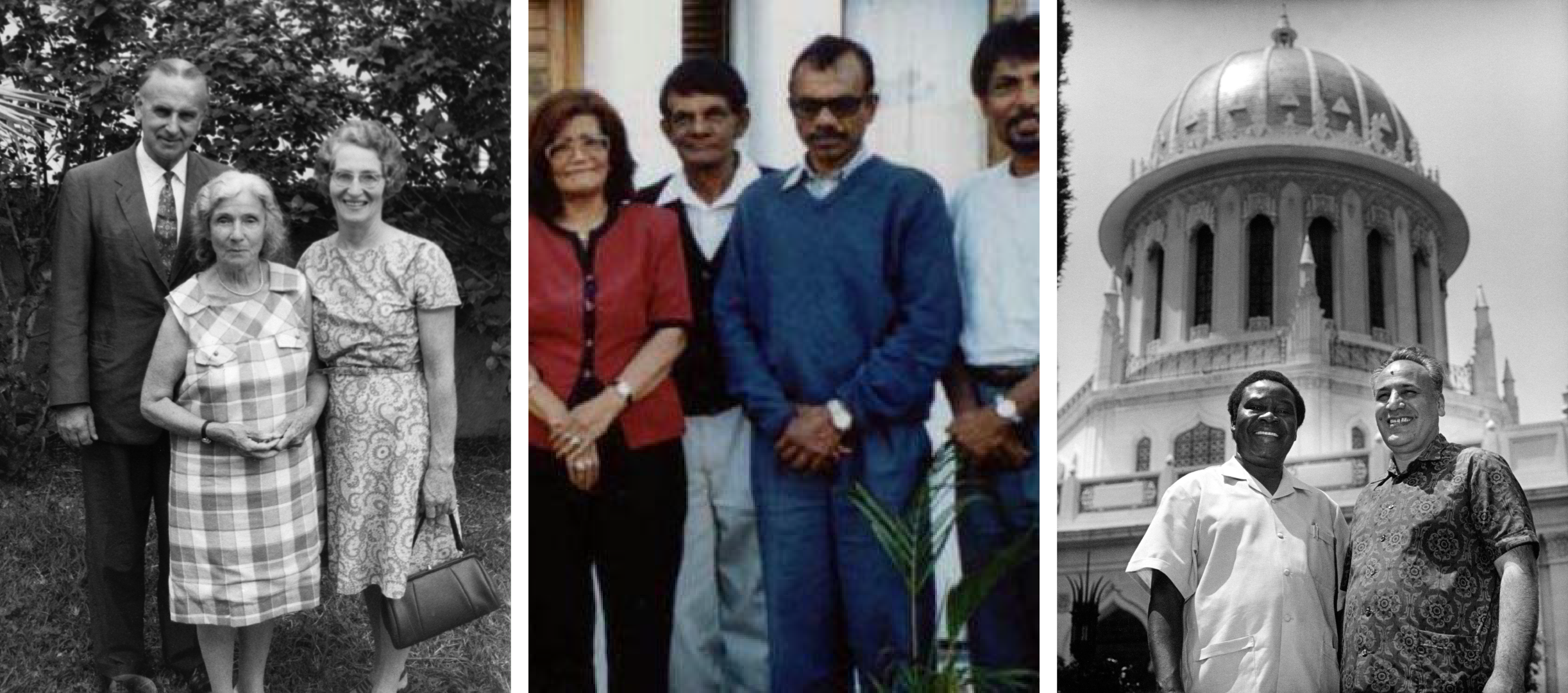
Left photograph: The three Knights of Bahá'u'lláh mentioned in the story below: Bertha Dobbins, with Hand of the Cause, Collis Featherstone and his wife, Madge, in May 1971. Source: Bahá'í World News Service. Center photograph: Pouva Murday—standing next to the woman in a red cardigan. Source: Bahá'í World News Service. Right photograph: Dr. Raḥmatu'lláh Muhájir with Enoch Olinga in Haifa. Source: Bahá'í Media Bank, © Bahá'í International Community 2023.
Of the pioneering goals initially set by the Guardian where the 257 Knights of Bahá'u'lláh settled, five remained virgin, and were settled only after the Ten Year Crusade had ended. By 1990, the Bahá'í Faith had penetrated every corner of the earth.
These and other stories of indomitable spirit, courage, steadfastness and self-abnegation are the subject of this book on the Knights of Bahá’u’lláh, those Bahá’ís who left their homes to bring the message of Bahá’u’lláh to countries and territories where it was unknown, and whose names are inscribed on Shoghi Effendi’s Roll of Honor. Here are three stories of courage under adversity:
Bertha and Joe Dobbins could not pioneer together, so Joe stayed home and his wife Bertha became a Knight of Bahá'u'lláh for the New Hebrides Islands. He supported her financially for 16 years until he passed away.
In order to stay on Chagos Islands and fulfill one of the Guardian’s goal for the Ten Year Crusade, Knight of Bahá'u'lláh Pouva Murday had to work for the company which owned the island. He peeled 650 coconuts a day, separating the husks from the fruit in appalling conditions for slave wages. He was beaten, his coworkers were often whipped, and some were even murdered, thrown into the shark-infested waters.
Raḥmatu'lláh Muhájir was a brilliant doctor who had just been offered a lucrative job with all the bonuses imaginable: a car, a driver, a house, and servants, and he and his wife Irán gave everything up to pioneer to the Mentawai Islands, where their house had holes in the roof, and their bathroom was an outdoor latrine made of two wooden planks over a stream filled with water snakes.
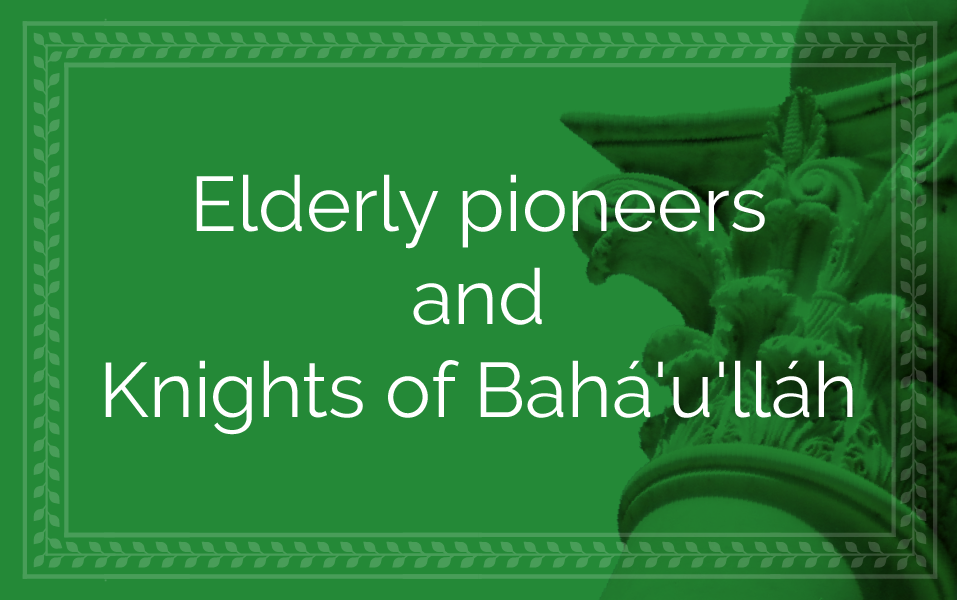
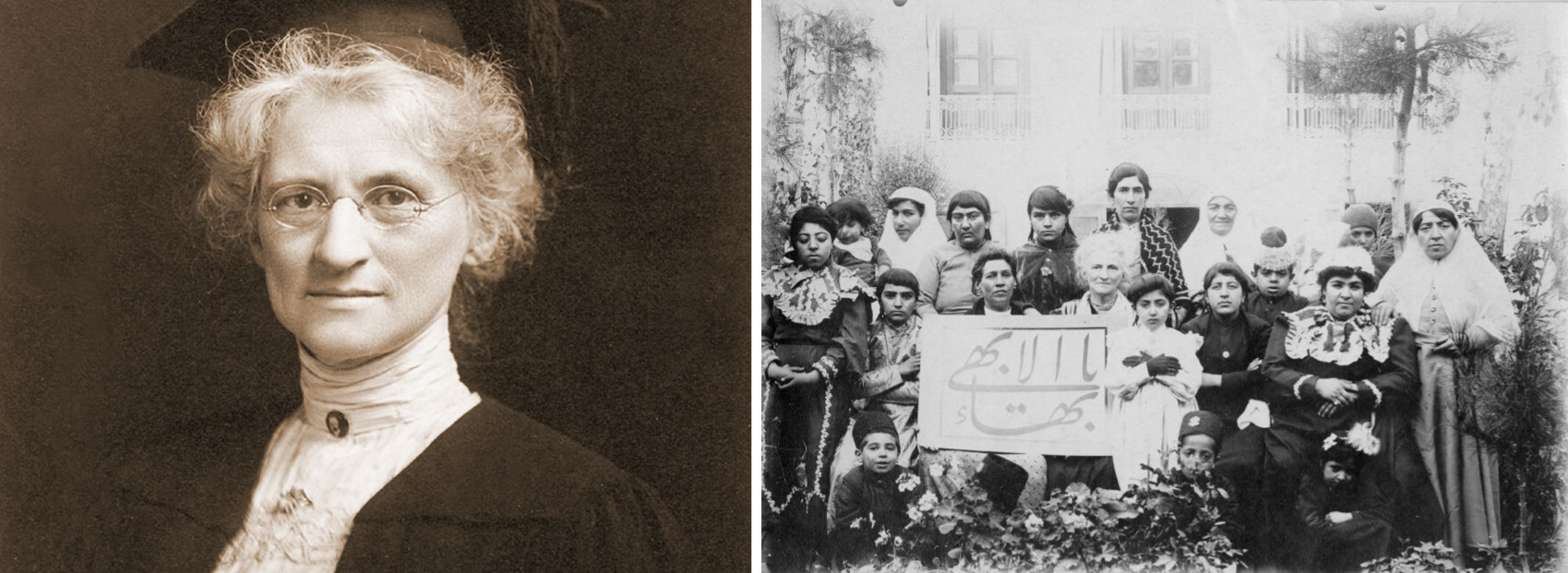
An example of an elderly servant of Bahá'u'lláh whom Shoghi Effendi met in his early childhood, and who would have made a deep impression on him on the capacity of elderly believers to render heroic and historic services to the Cause. Dr. Susan Moody learned about the Bahá'í Faith at the age of 52 in 1903 through Isabella Brittingham, as she was earning her medical degree. Dr. Susan Moody in her graduation attire, she had returned to medical school at the age of 50 in 1901. At 'Abdu'l-Bahá’s request, Dr. Susan Moody moved to Iran at the age of 58 in 1909, and began practicing medicine in particular treating gynecology, obstetrics, and women's diseases opening a private practice and practicing at the Sehat Hospital. Dr. Moody was the second female physician in Iran. Source: Brilliant Star Magazine. Photograph of Dr. Moody with Baha’i women in Ṭihrán in 1910. These women were some of the first to appear in public without veils. Source: Harvard University, Middle Eastern Divison.
Many of the people around Shoghi Effendi—including his closest advisors like Rúḥíyyih Khánum and Leroy Ioas—did not have the vision he had and often dismissed elderly people as not capable of rising up in the Ten Year Crusade.
Not the Guardian.
The Guardian respected everyone, and did not discriminate according to age. Below are 4 stories of elderly Bahá'ís arising to pioneer and serve.
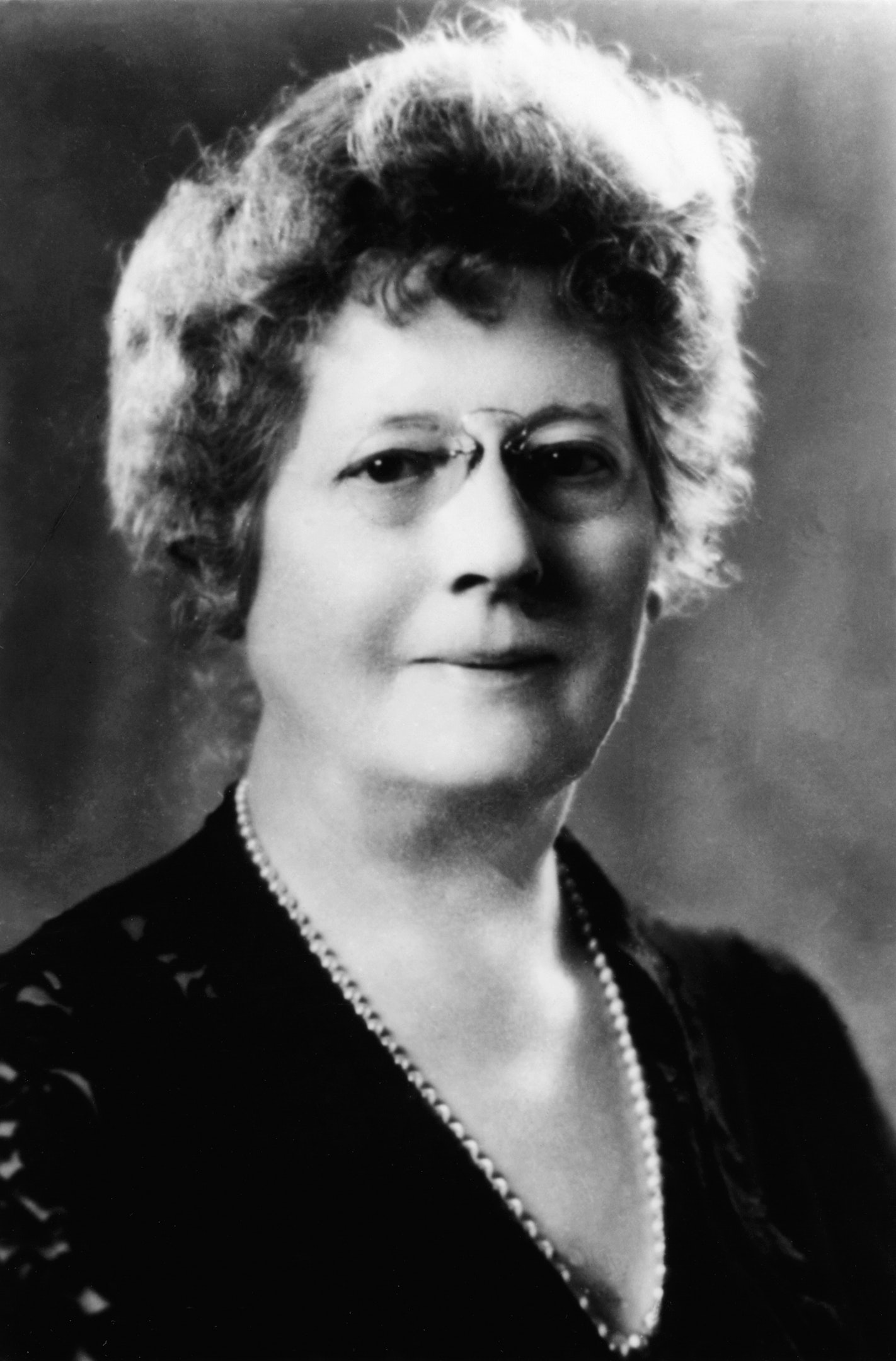
Nellie French, Knight of Bahá’u’lláh for Monaco. Source: Bahá'í Media Bank, © Bahá'í International Community 2023.
Nellie French was born in Peoria, Illinois on 19 October 1868 to an Episcopalian father and a Quaker mother. Nellie French was born two months after Bahá'u'lláh entered the Most Great Prison.
In 1888, Nellie French traveled to Naples, Italy, to study operatic singing, and became fluent in French and Italian, she returned to the United States four years later in 1892, the year of Bahá'u'lláh’s Ascension.
Nellie French was one of the earliest Bahá'ís in the United States, learning of the Faith in 1896 in Chicago. After this, Nellie moved to Arizona, then to Pasadena, California. In 1921, Nellie and her husband Stuart met 'Abdu'l-Bahá on pilgrimage in 1921, in the last months of His life. In 1929, Nellie was elected to the National Spiritual Assembly of the United States and Canada. She was Chair of the Bahá'í World Editorial Committee for 16 years from 1930 to 1946. She produced Braille plates for the Kitáb-i-Aqdas and Bahá'u'lláh and the New Era and in the mid-1930s, she visited Lima, Valparaiso, Magallanes, São Paulo, Bahia, and Rio de Janeiro on a lengthy teaching tour.
On her second pilgrimage in 1952, at the age of 84, she met Shoghi Effendi. When the Ten Year Crusade began in 1953, Nellie French pioneered to the goal country of Monaco, arriving on 12 September 1953, and Shoghi Effendi named her a Knight of Bahá'u'lláh.
Nellie French died on 3 January 1954, four months after arriving.
She was 85 years old, and the oldest Knight of Bahá'u'lláh in the world. After her passing the Guardian sent the following cable:
Deeply regret passing valiant pioneer. Long record services, highly meritorious. Praying progress soul Kingdom.
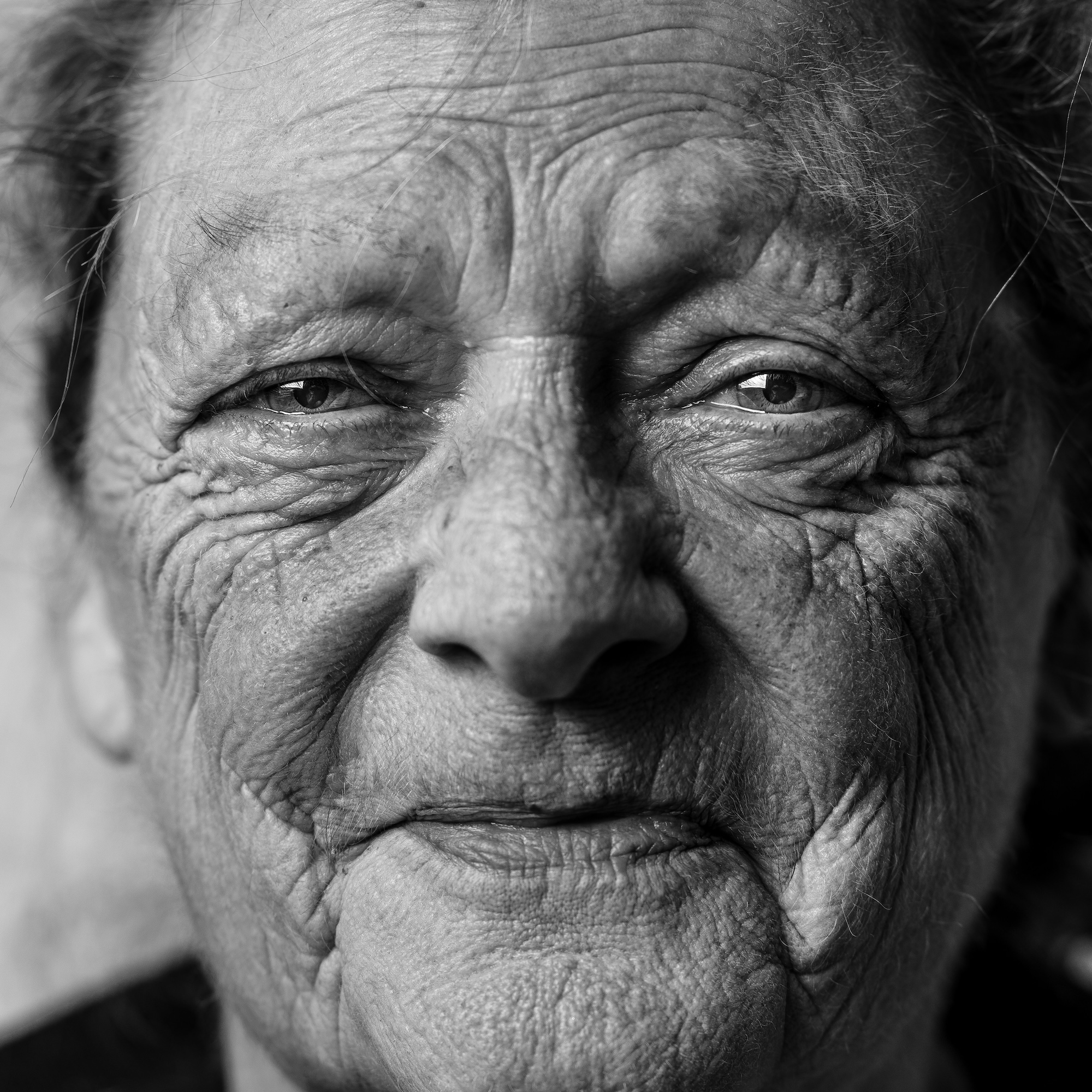
An exquisite photograph of an elderly woman. Photo by Glen Hodson on Unsplash.
One evening, the Guardian arrived at dinner with a telegram from the National Spiritual Assembly of the United States regarding a sick, elderly woman who was insistent that she pioneer in one of the hardest posts. The National Assembly stated that her health was not good and she was not an effective teacher of the Cause, and so, should not be sent.
Even Rúḥíyyih Khánum spoke up:
Shoghi Effendi, surely you are not going to send this person. I know her very well. She is not a good teacher, she knows nothing about the teaching work, she is sick and will need assistance and will not be able to do anything.
The Guardian said he had already cabled the National Spiritual Assembly to let the woman leave at once, saying to Rúḥíyyih Khánum and those present:
What you are forgetting is that the leaven of the world today is the Holy Spirit released by Baha'u'llah, which quickens the souls of men, and the Holy Spirit is brought to a new area only through a Baha'i, there is no other way. If that woman goes to that island and never opens her mouth, she has brought the spirit of Baha'u'llah there and the leavening process has begun. If there is even one area which remains unsettled, that area is deprived of the influence of Baha'u'llah.

Victoria Bedekian, “Auntie Victoria,” with a large group of international youth. Auntie Victoria is in the center in a dark dress with a friend’s hands on her shoulders. Source: Brilliant Star Magazine.
Some elderly Bahá'ís could not travel, teach, or arise to pioneer, but served in their own, useful and modest ways, for example, Auntie Victoria—Victoria Bedekian—who made drawings for pioneers with inspirational quotations for the writings so they could offer them to seekers, or to decorate their homes.
Leroy Ioas wrote to thank Auntie Victoria and told her:
I need your prayers, as does everyone here. The tasks are many and often very arduous, but the love and prayers of the friends make them easier. The great reward is lifting some of the burden of the beloved Guardian, whose work has increased many fold since the opening of the Crusade. We are all working harder to absorb more of it for him [Shoghi Effendi], so as to give him some relief.

'Abdu'l-Bahá with the Kinney family in 1912, during His journey to America. The husband is Saffa Kinney and the wife is Vaffa Kinney. Source: © United States National Bahá'í Archives, used with permission.
Some elderly Bahá'ís could not travel internationally, but it did not stop them from homefront pioneering, like Vaffa Kinney, 70 years old, a widowed beloved early Bahá'í from New York City who had frequently hosted 'Abdu'l-Bahá in 1912.
Vaffa Kinney pioneered from the home she had lived in her entire life in New York City to the small town of River Edge across the Hudson. Leroy Ioas wrote to her on behalf of Shoghi Effendi:
The Guardian is greatly pleased with the devotion and consecration of the friends in River Edge and hopes they will establish a strong and thriving Assembly. Your own devoted services are greatly valued, and he is sure the Master will richly reward you, both here and in the hereafter.
SOURCES FOR PART XVIII
1952: The Guardian’s 30 years of spiritual and administrative preparation for the Ten Year Crusade
Bahá’í Library Online: The 22nd Ḥasan M. Balyúzí Memorial Lecture, The Ten Year Crusade, ‘Alí Nakhjávání, published in Journal of Bahá’í Studies, 14:3-4, pages 1-33, Ottawa: Association for Bahá’í Studies North America, 2004, pages 1-4.
Bahá’í Library Online: The 22nd Ḥasan M. Balyúzí Memorial Lecture, The Ten Year Crusade, ‘Alí Nakhjávání, published in Journal of Bahá’í Studies, 14:3-4, pages 1-33, Ottawa: Association for Bahá’í Studies North America, 2004, pages 5-6.
Leroy Ioas: Hand of the Cause of God, Anita Ioas Chapman, George Ronald, 1998, pages 248-255.
Bahaipedia: Ten Year Crusade.
Shortly before 9 July 1952: The Wheels of Bahá’u’lláh’s Chariot
Bahá’í Library Online: Letters from Jessie Revell (1952), Letter dated 9 July 1952, sent to the Friends in America, page 1.
Summer 1952 in Switzerland: How Shoghi Effendi devised the goals of the Ten Year Crusade
The Priceless Pearl, Rúḥíyyih Rabbání, Bahá’í Publishing Trust, London, 1969, pages 410-411.
30 June 1952: The Guardian’s message about the Summons of the Lord of Hosts
The passionate appeal of the Guardian
REFERENCES FOR THE TWO PREVIOUS STORIES:
Messages to the Bahá’í World: 1950–1957, Shoghi Effendi, Bahá’í Publishing Trust, Wilmette, Illinois, 1971, pages 38-39.
Leroy Ioas: Hand of the Cause of God. Anita Ioas Chapman, George Ronald, 1998, page 253.
Messages to the Bahá’í World: 1950–1957, Shoghi Effendi, Bahá’í Publishing Trust, Wilmette, Illinois, 1971, pages 31-39.
1952: The Bahá’í Faith: 1844-1952: Information Statistical and Comparative
The content of Information Statistical and Comparative: 1844 – 1952
REFERENCES FOR THE PREVIOUS TWO STORIES:
A World Survey of the Bahá’í Faith: 1844 – 1944, Shoghi Effendi.
Bahá’í Library Online: compiled by Shoghi Effendi Wilmette: Bahá’í Publishing Committee, 1953.
Bahá’í Library Online: The Bahá’í Faith: 1844-1952: Information Statistical and Comparative compiled by Shoghi Effendi Wilmette: Bahá’í Publishing Committee, 1953.
Leroy Ioas: Hand of the Cause of God. Anita Ioas Chapman, George Ronald, 1998, page 249.
Shoghi Effendi: Recollections, Ugo Giachery, George Ronald, 1973, pages 43-44.
5 August 1952: The 4 objectives of the Ten Year Crusade
Late August 1952: The Guardian returns from Switzerland with a new energy
8 October 1952: The 27 goals of the Ten Year Crusade
Riḍván 1953: The conclusion of the African Campaign
Bahaipedia: African Campaign.
Messages to the Bahá’í World: 1950–1957, Shoghi Effendi, Bahá’í Publishing Trust, Wilmette, Illinois, 1971, pages 62 and 71.
The ten stages of the 6,000-year religious process
REFERENCES FOR THE PREVIOUS TWO STORIES:
Messages to the Bahá’í World: 1950–1957, Shoghi Effendi, Bahá’í Publishing Trust, Wilmette, Illinois, 1971, pages 40 and 153-156.
Begin Ninth Part Majestic Process: 4 May 1953 letter from Shoghi Effendi to the Bahá’í World. For this section, see page 153 of Messages to the Bahá’í World: 1950–1957.
The three phases of the first half of the Ten Year Crusade
The Priceless Pearl, Rúḥíyyih Rabbání, Bahá’í Publishing Trust, London, 1969, page 424.
22nd Ḥasan M. Balyúzí Memorial Lecture: The Ten Year Crusade, ‘Alí Nakhjávání, pages 11-12.
The Ten Year Crusade: Everywhere, everyone, all at once
Leroy Ioas: Hand of the Cause of God, Anita Ioas Chapman, George Ronald, 1998, pages 248-255.
Violetta Zein, The Blessed Beauty illustrated chronology: “The fame of the Cause has reached as far as Díyárbakr!”
Bahaipedia: Ten Year Crusade.
The Guardian’s descriptions of the Ten Year Crusade
Bahá’í Library Online: The 22nd Ḥasan M. Balyúzí Memorial Lecture, The Ten Year Crusade, ‘Alí Nakhjávání, published in Journal of Bahá’í Studies, 14:3-4, pages 8-9.
Messages to the Bahá’í World: 1950–1957, Shoghi Effendi, Bahá’í Publishing Trust, Wilmette, Illinois, 1971.
What is a Knight of Bahá’u’lláh?
REFERENCES FOR THE PREVIOUS TWO STORIES:
The Priceless Pearl, Rúḥíyyih Rabbání, Bahá’í Publishing Trust, London, 1969, page
The Knights of Bahá’u’lláh, Earl Redman, George Ronald, 2017, Kindle Edition, INTRODUCTION.
Leroy Ioas: Hand of the Cause of God, Anita Ioas Chapman, George Ronald, 1998, page 260.
Who were the Knights of Bahá’u’lláh?
The Knights of Bahá’u’lláh, Earl Redman, George Ronald, 2017, Kindle Edition, INTRODUCTION, Locations 414-675, 8510.
Bahá’í World News Service: Cameroon celebrates golden time, 23 August 2003.
Bahá’í World News Service: Light of the spirit shines in the Congo, 29 August 200.
7 December 1953: the Guardian’s marching orders for all Knights of Bahá’u’lláh
The Knights of Bahá’u’lláh, Earl Redman, George Ronald, 2017, Kindle Edition, Location 651.
September 1953: The Roll of Honor
Leroy Ioas: Hand of the Cause of God. Anita Ioas Chapman, George Ronald, 1998, page 261.
The Knights of Bahá’u’lláh, Earl Redman, George Ronald, 2017, Kindle Edition, INTRODUCTION: Location 483.
The Priceless Pearl, Rúḥíyyih Rabbání, Bahá’í Publishing Trust, London, 1969, page 425.
Messages to the Bahá’í World: 1950–1957, Shoghi Effendi, Bahá’í Publishing Trust, Wilmette, Ill. 1971, page 49.
Messages to the Bahá’í World: 1950–1957, Shoghi Effendi, Bahá’í Publishing Trust, Wilmette, Illinois, 1971, pages 49-50.
Email communication with Earl Redman, 4 August 2021 regarding the origin of the term “Knights of Bahá’u’lláh.”
Bahaipedia: Knights of Bahá’u’lláh.
Bahá’í Library Online: Roll of Honor Bahá’í World Crusade 1953-1963, designed by Shoghi Effendi, published in Bahá’í World, Vol. 20 (1986-1992), Haifa: Bahá’í World Centre, (1998)
Why do some territories have so many names listed as Knights of Bahá’u’lláh with different dates?
The Knights of Bahá’u’lláh, Earl Redman, George Ronald, 2017, Kindle Edition, INTRODUCTION, Location 557.
1953 – 1963: Virgin territories opened during the Ten Year Crusade
The Knights of Bahá’u’lláh, Earl Redman, George Ronald, 2017, Kindle Edition.
Bahaipedia: Knights of Bahá’u’lláh.
The five remaining virgin territories opened after the Ten Year Crusade
The Knights of Bahá’u’lláh, Earl Redman, George Ronald, 2017.
October 1953: ‘Alí and Violette Nakhjávání and the 5,000-kilometer adventure
Bahá’í Library Online chronology: Enoch Olinga.
The Knights of Bahá’u’lláh, Earl Redman, George Ronald, 2017, Kindle Edition, Location 1919.
April 1954: Enoch Olinga: The father of victories
The Knights of Bahá’u’lláh, Earl Redman, George Ronald, 2017, Kindle Edition, Location 1940.
Wikipedia: Enoch Olinga.
14 April 1954: Edward Tabe: The youngest Knight of Bahá’u’lláh
The Knights of Bahá’u’lláh, Earl Redman, George Ronald, 2017, Kindle Edition, Locations 2217-2231.
Bahaipedia: Edward Tabe.
4 June 1955: Frank Wyss: The Knight of Bahá’u’lláh who never left the airport
The Knights of Bahá’u’lláh, Earl Redman, George Ronald, 2017, Kindle Edition, Locations 3672-3716.
Bahaipedia: Frank Wyss.
Wikipedia: Cocos (Keeling) Islands.
WhatsApp conversation with Rahim Mazlum dated 7 December 2023 for location of the Cocos Islands airport.
Wikipedia: Cocos (Keeling) Islands Airport.
11 October 1953: Fawzi and Bahia Zaynu’l-‘Ábidín: My grandparents
The Knights of Bahá’u’lláh, Earl Redman, George Ronald, 2017, Kindle Edition, Locations 1162-
The Bahá’í World Volume 16: In Memoriam: Fawzí Zaynu’l-‘Ábidín.
Conversations with Bahia Zein-Garden, Violetta Zein, 15 September 2001.
The Knights of Bahá’u’lláh, Earl Redman, George Ronald, 2017, Kindle Edition, INTRODUCTION, Locations 414-675, 8510.
Bahá’í World News Service: Cameroon celebrates golden time, 23 August 2003.
Bahá’í World News Service: Light of the spirit shines in the Congo, 29 August 200.
Shoghi Effendi Through the Pilgrim’s Eye, Volume 2 The Ten Year Crusade, 1953-1963. Earl Redman, George Ronald, Oxford, 2016, Kindle Edition, Location 6788.
The Knights of Bahá’u’lláh, Earl Redman, George Ronald, 2017, Kindle Edition, Locations 464.
The Guardian’s respect for the service of the elderly
Personal observations of the author.
12 September 1953: Nellie French: The oldest Knight of Bahá’u’lláh
The Knights of Bahá’u’lláh, Earl Redman, George Ronald, 2017, Kindle Edition, Locations 8311-8327.
Bahaipedia: Nellie French.
Auntie Victoria: Support and encouragement
Vaffa Kinney: Homefront pioneering
REFERENCES FOR THE PREVIOUS THREE STORIES:
Leroy Ioas: Hand of the Cause of God, Anita Ioas Chapman, George Ronald, 1998, pages 259-260.
![]()
 1944 – 1953: Spiritual preparation: The Guardian’s “accessory plans” for National Spiritual Assemblies
1944 – 1953: Spiritual preparation: The Guardian’s “accessory plans” for National Spiritual Assemblies
